Indochina, Air Mail Stamps, June 1st, 1933, Michel Nr. IND 184-197; Fourteen stamps in nominals of1C, 2C, 5C, 10C, 15C, 20C, 30C, 36C, 60C, 66C, 1P, 2P, 5P and 10P were issued in perforation 13.5.
Here is the complete mint never hinged set.
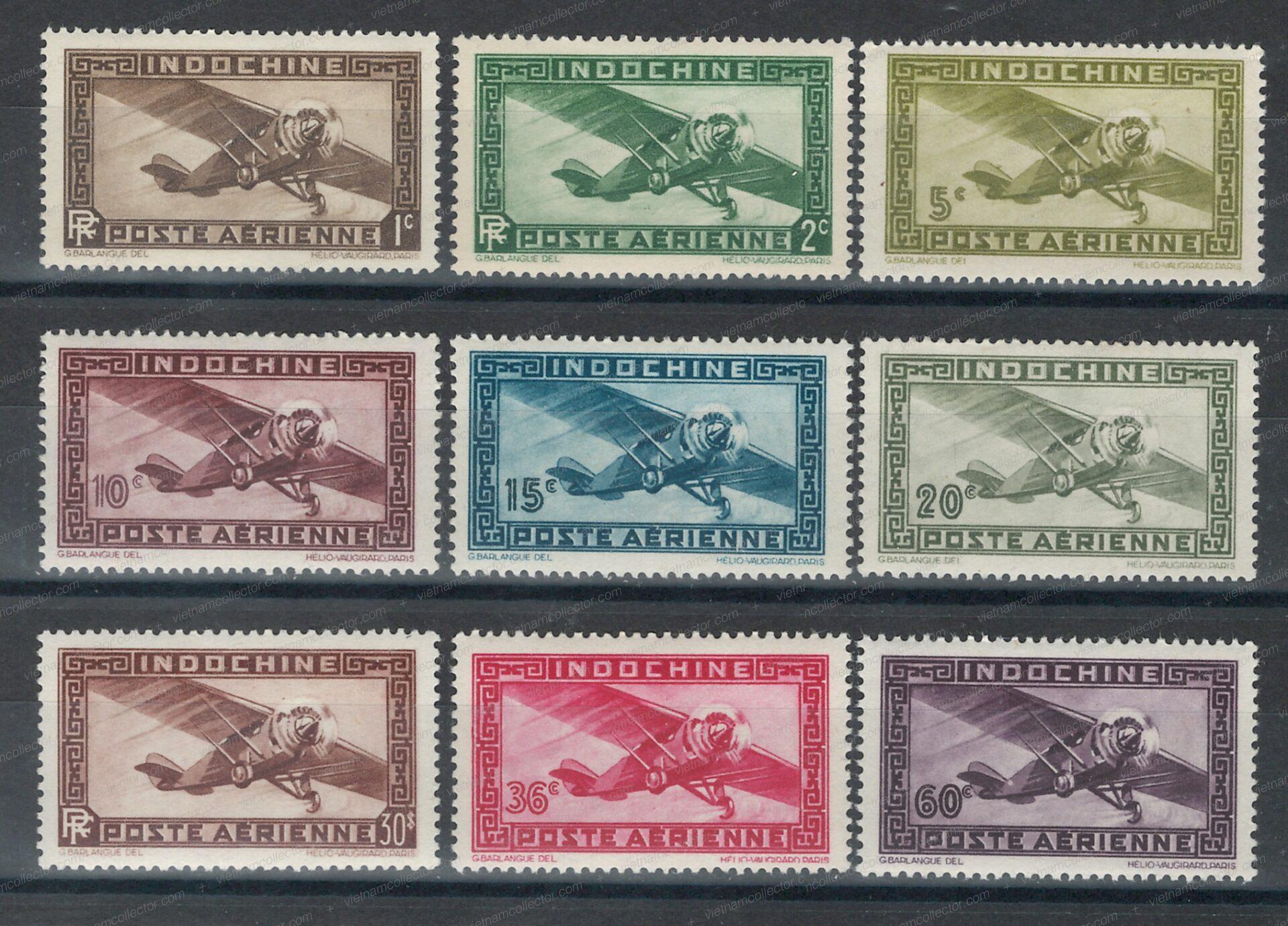
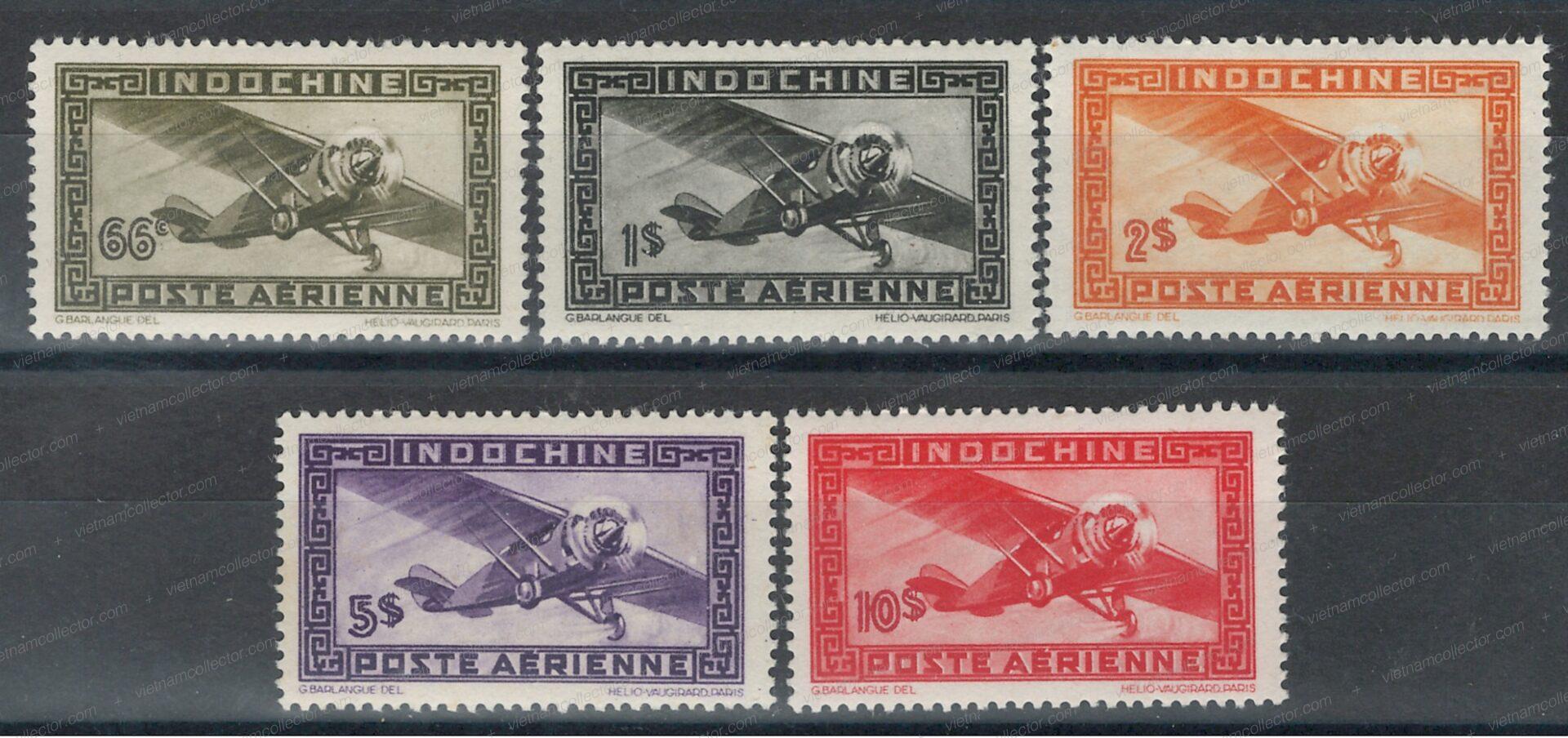
and here some postally used stamps
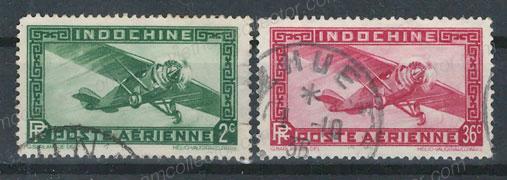
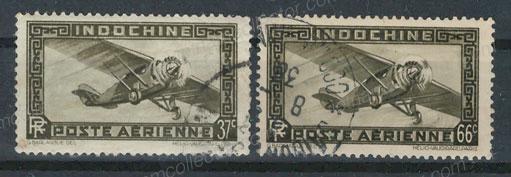
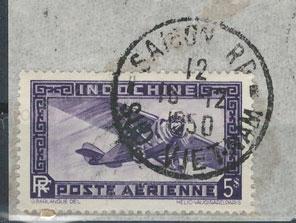
Partial sheet of the 1C value cancelled to order.
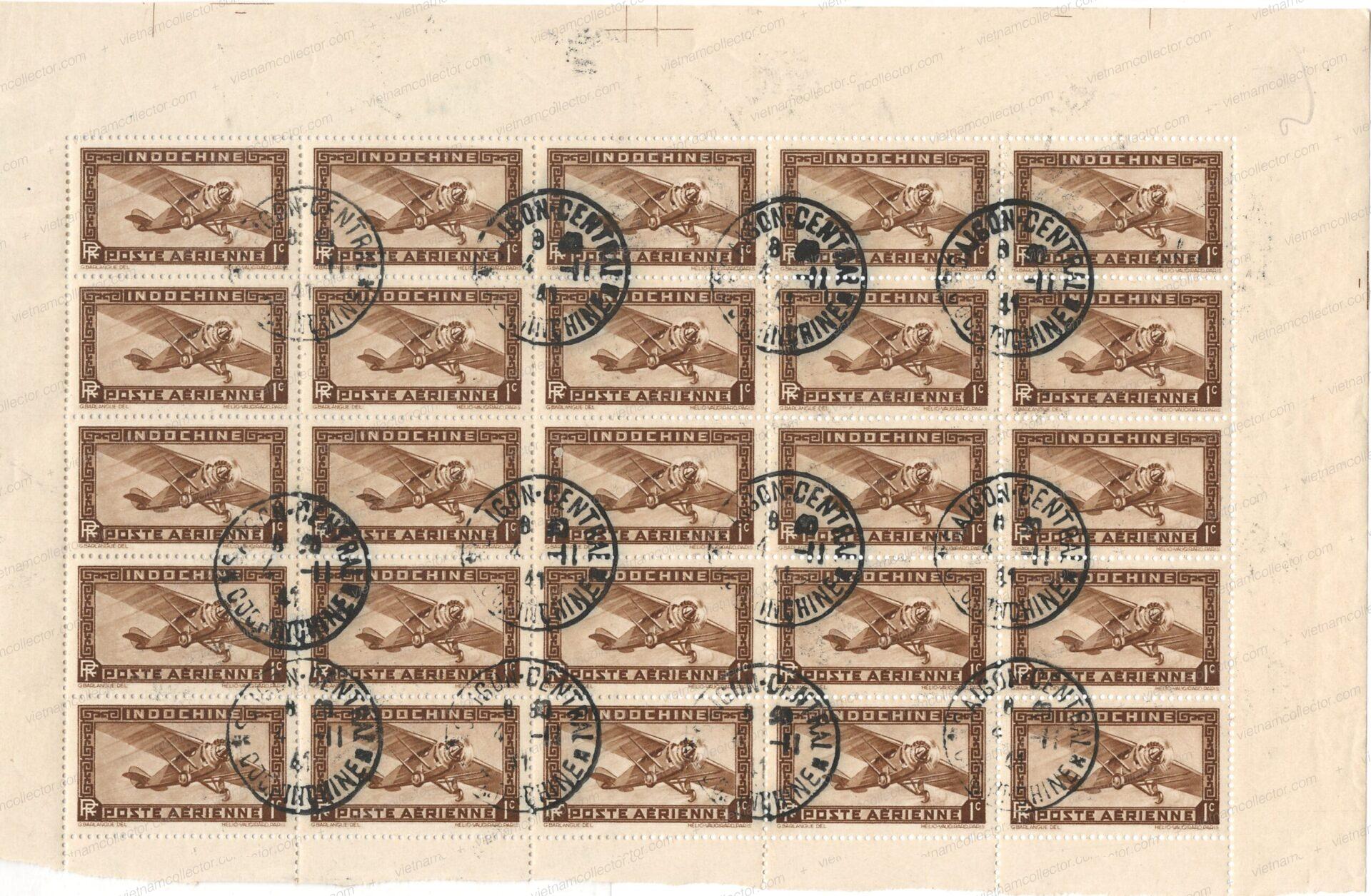
Very rare multiple franking of the 1C value (5) paying an overall postage of 5C on a domestic letter sent from Phnom Penh to Kampong Trach. The letter originated with a missionary with the name of N.M. Cressman and most likely contained printed matter. Legally the Indochina Government had a monopoly on all mail distribution. This meant that even letters handled by private courier had to be franked with Indochinese stamps. This letter is from the collection of the Swiss national Walberg. He annotated his collection of this item as follows:
Letter sent by “Nature Bus” from Pnompenh to Kompong-Trach in Cambodia. Franked with 5C, 5x1c i a block-of-4 1C Air Mail stamps of 1933. Cancelled by manuscript “CARRIED BY NATURE BUS 9/19/33 N.M. CRESSMAN” A probably unique item.
A parallel to this mail handling existed even into the 1950’s in South Vietnam. Even secret pouch mail from foreign embassies had to be franked with South Vietnamese stamps that were then cancelled in the destination country.

Mixed franking of the 1C and 2C Air Mail stamps together with the Indochinese Railway stamps paying an overall postage of 40C on an international letter sent from Pleiku to France via the French military postal system (note the Poste aux Armee mute cancel).
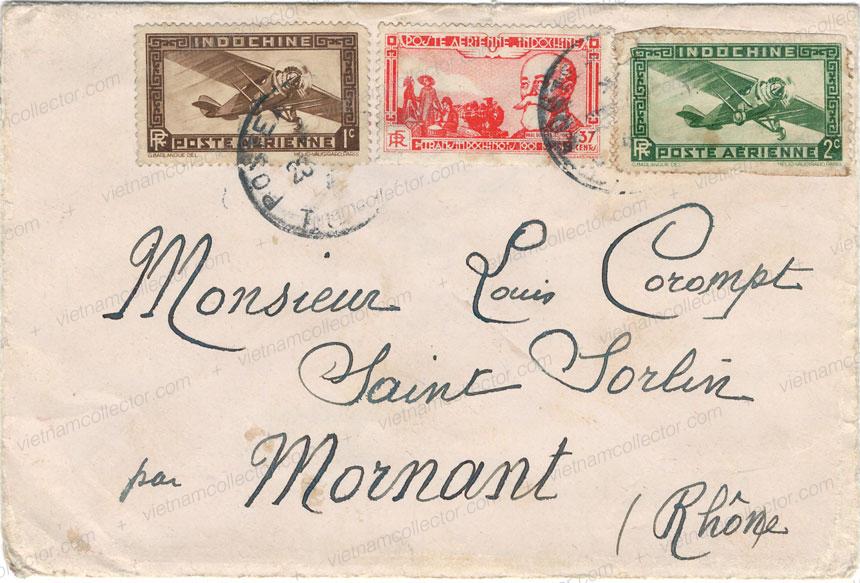
Mixed franking of the 2C Air Mail together with the 4C and 5C Domestic Scenes II stamps paying an overall postage of 11C on a First Flight Cover inaugurating the opening of the air route from Vientiane, Laos to Saigon on July 7th, 1939.
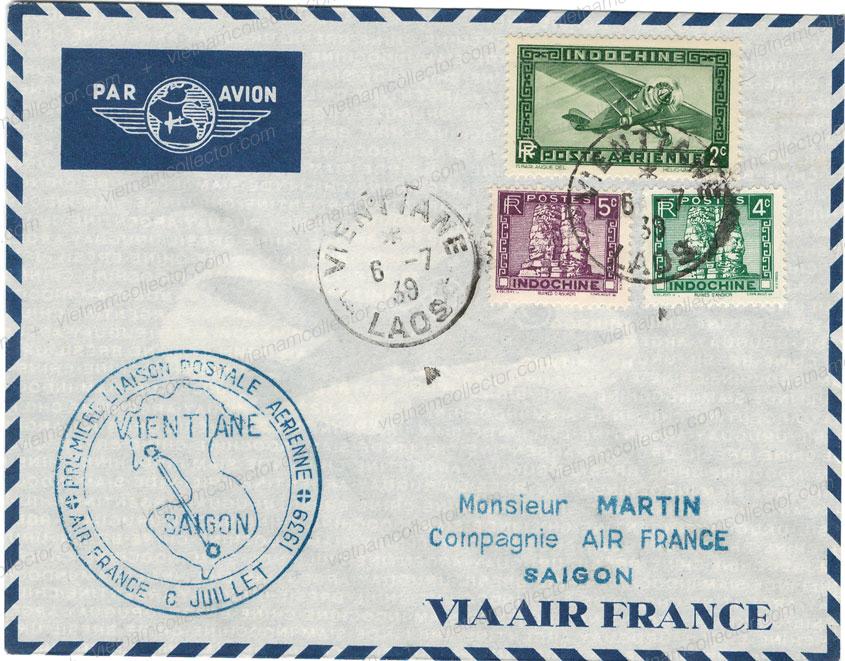
Mixed franking of two 5C Air Mail stamps together with two 15C Domestic Scences stamps paying the proper international rate of 40C on a rare international letter sent from Phnom Penh to Singapore in February 1944. Both, Singapore and Indochina were occupied by the Japanese Army at the time so thee letter was not censored. Saigon transfer cancel on the reverse.

Mixed ranking of the 10C Air Mail and 5C Domestic Scenes II stamps paying an overall postage of 15C on an international letter sent from Hue in July of 1936 to Switzerland. Nha Trang transit cancel on the reverse.
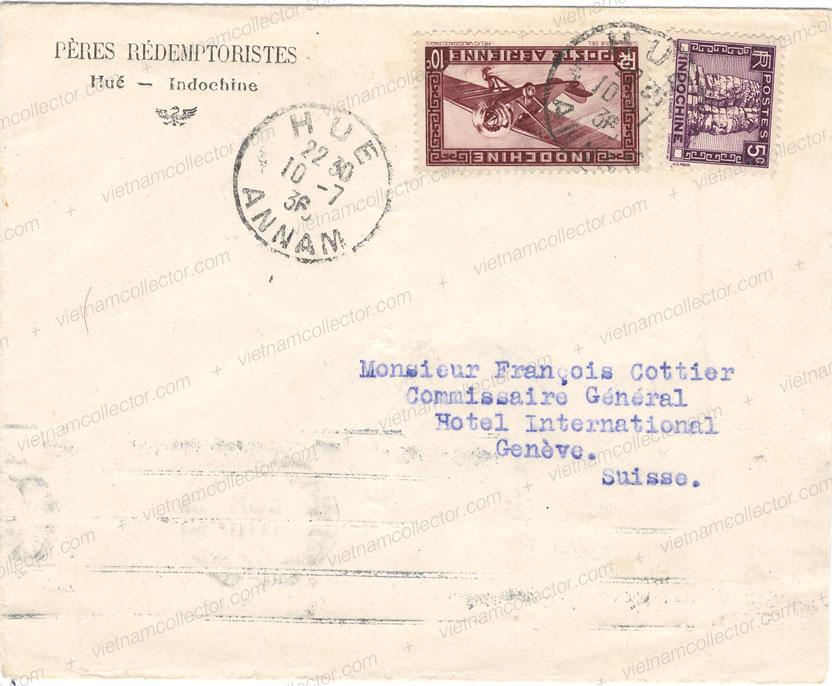
Mixed franking of the 2C (2), 4C and 15C Bao Dai together with stamps from the Air Mail and Domestic Scenes sets paying an overall postage of 36C on an international air mail letter front sent from Lang Son to France in January of 1937.
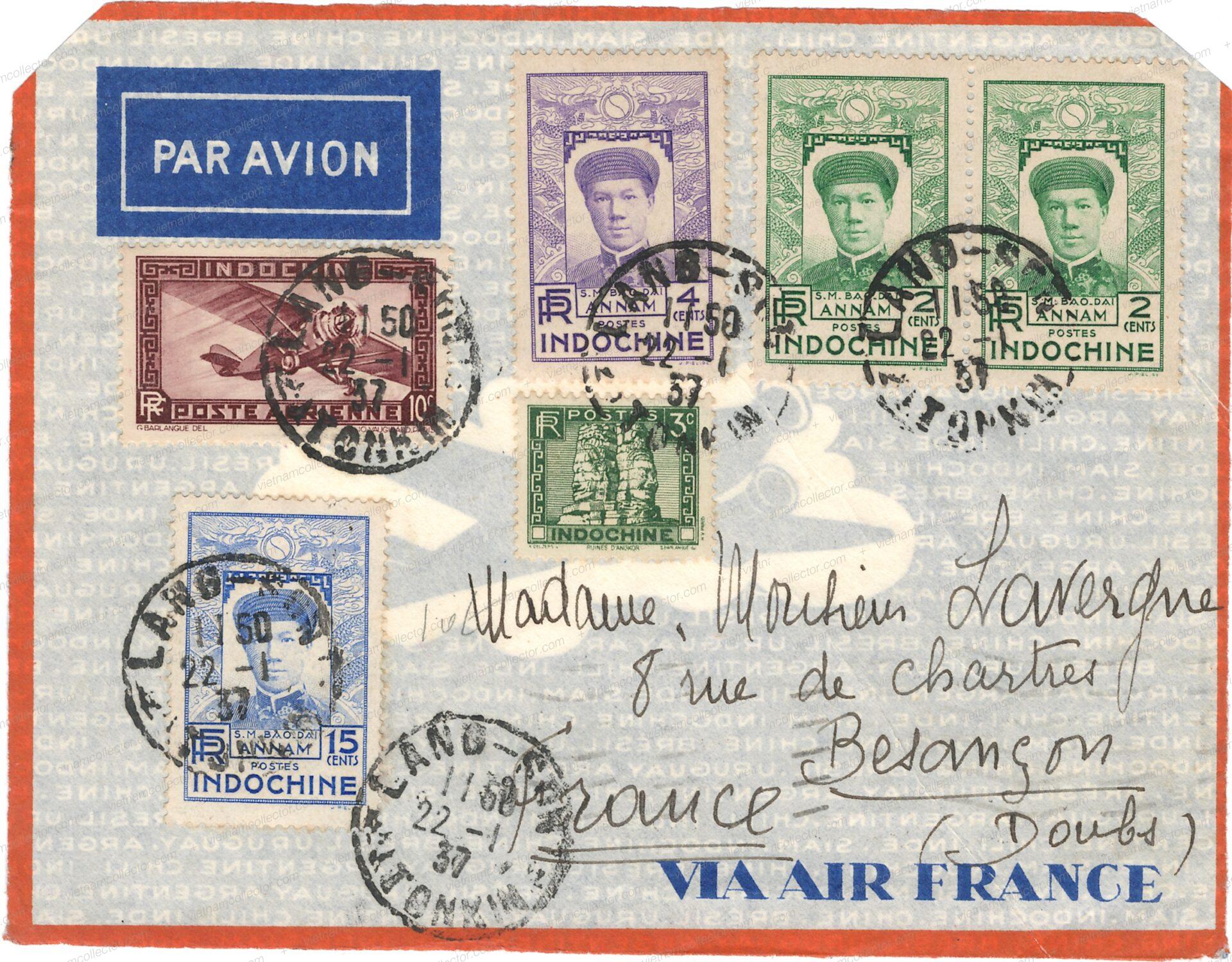
Single franking of the 11C value on a domestic airmail letter setoff rom Hanoi to Saigon in July of 1938. The letter carries the blue First Flight Cachet for a new 5 hour flight from Hanoi to Saigon on July 30th, 1938. Signed by the captains of the plane in front.
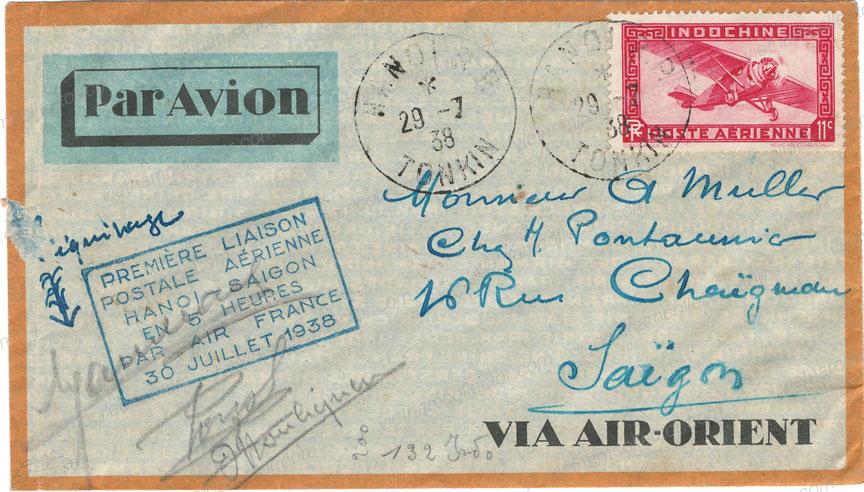
Single franking of the 11C stamp on a First Flight Cover inaugurating the new air route Saigon-Vientiane-Hanoi on July 6th, 1939. Hanoi arrival cancel on the reverse.
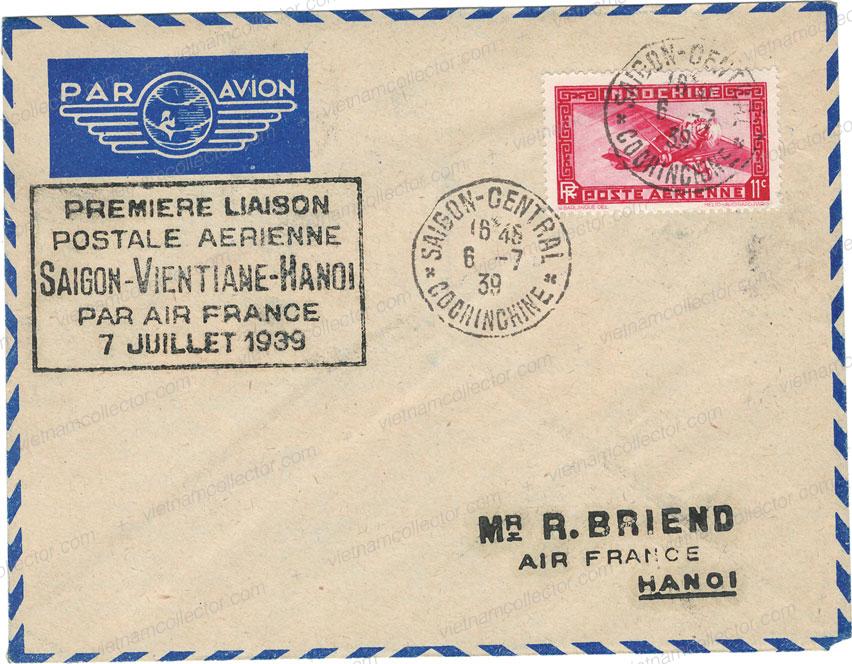
Multiple franking of the 11C values (2) paying an overall postage of 22C on an international printed matter card sent from Cholon to Courances in France in December of 1947. Rare octagonal rural Saigon cancel.
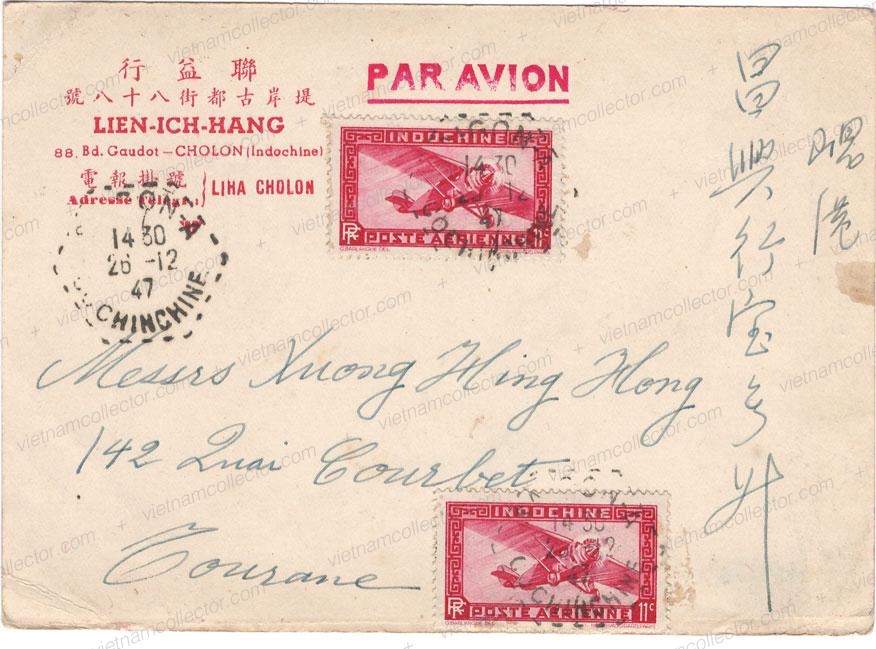 Mixed franking of the 16C and 69C stamps paying an overall postage of 85C on an international air mail letters sent from Saigon to France in June of 1946. First Flight cachet indicating the re-opening of the Indochina to France line on January 20th, 1946 on the reverse.
Mixed franking of the 16C and 69C stamps paying an overall postage of 85C on an international air mail letters sent from Saigon to France in June of 1946. First Flight cachet indicating the re-opening of the Indochina to France line on January 20th, 1946 on the reverse.
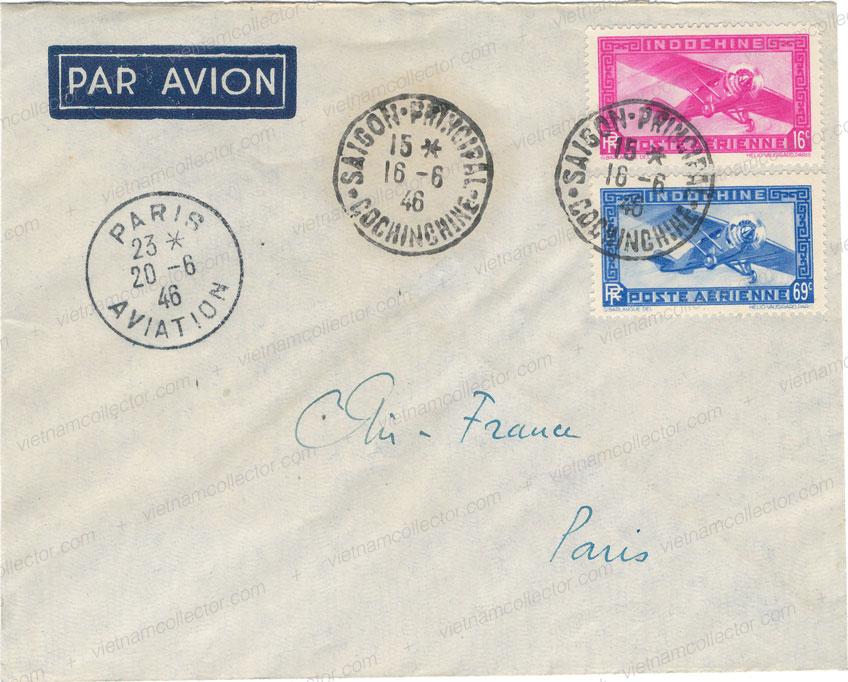
 Mixed franking of the 10C and 30C values on an international air mail letter sent from Can Tho to India in November of 1934. Saigon transit and Indian arrival cancels on the reverse.
Mixed franking of the 10C and 30C values on an international air mail letter sent from Can Tho to India in November of 1934. Saigon transit and Indian arrival cancels on the reverse.
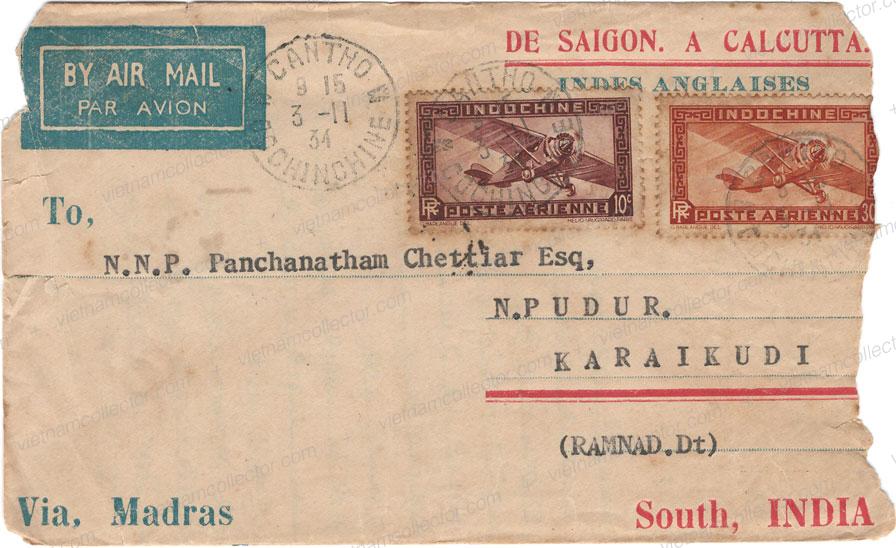 Multiple franking of the 20C value (2) paying an overall postage of 40C on an international air mail letter sent from Saigon to India in July of 1935. Various Indian arrival and distribution cancels on the reverse.
Multiple franking of the 20C value (2) paying an overall postage of 40C on an international air mail letter sent from Saigon to India in July of 1935. Various Indian arrival and distribution cancels on the reverse.
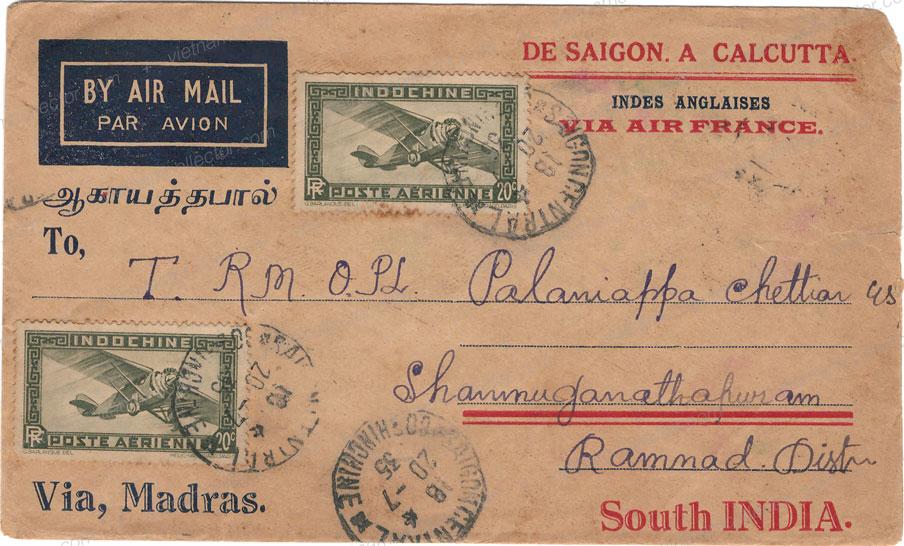 Single franking of the 30C value on a registered air mail letter sent from Saigon to India in December of 1936. Indian arrival cancel on the reverse.
Single franking of the 30C value on a registered air mail letter sent from Saigon to India in December of 1936. Indian arrival cancel on the reverse.
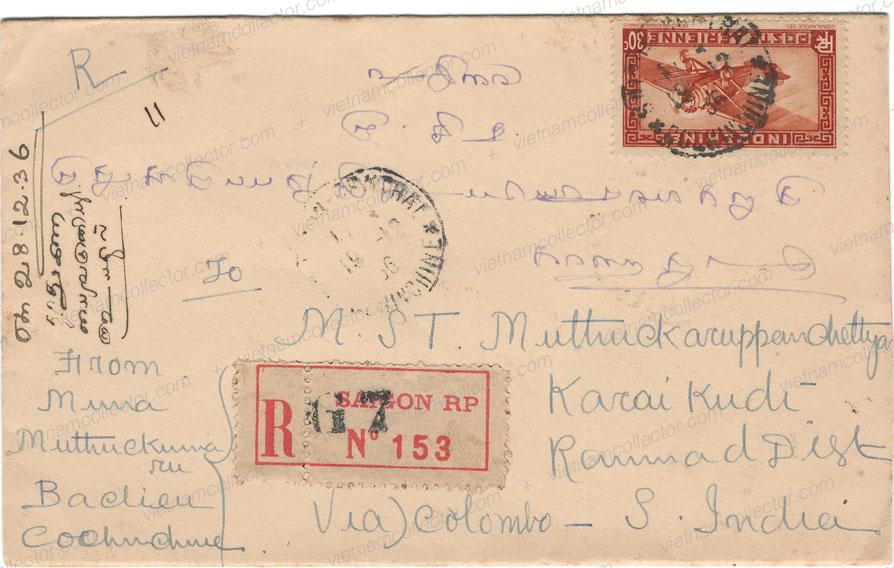 Single franking of the 30C value on a registered air mail letter sent from Saigon to India in August of 1936. Indian arrival cancels on the reverse.
Single franking of the 30C value on a registered air mail letter sent from Saigon to India in August of 1936. Indian arrival cancels on the reverse.
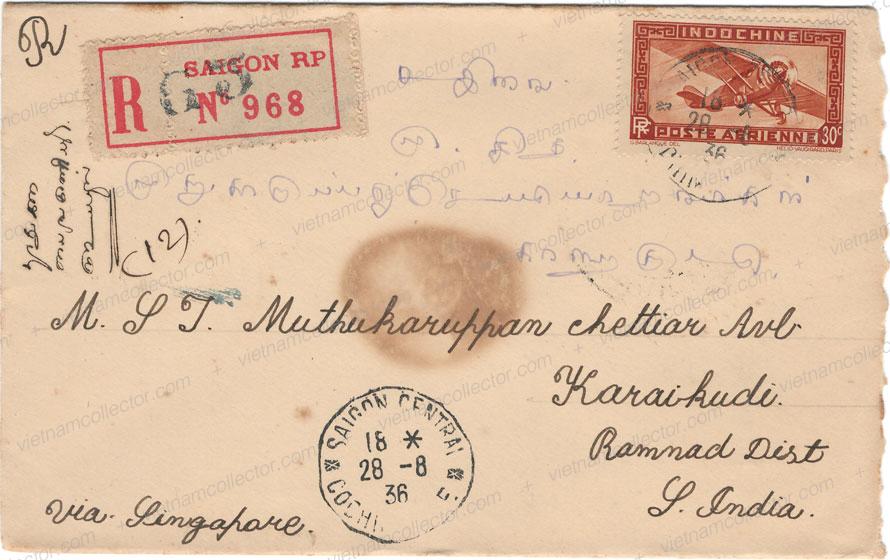 Single franking of the 30C value on a registered air mail letter sent from Hanoi to France in May of 1940. Indian arrival cancel on the reverse.
Single franking of the 30C value on a registered air mail letter sent from Hanoi to France in May of 1940. Indian arrival cancel on the reverse.
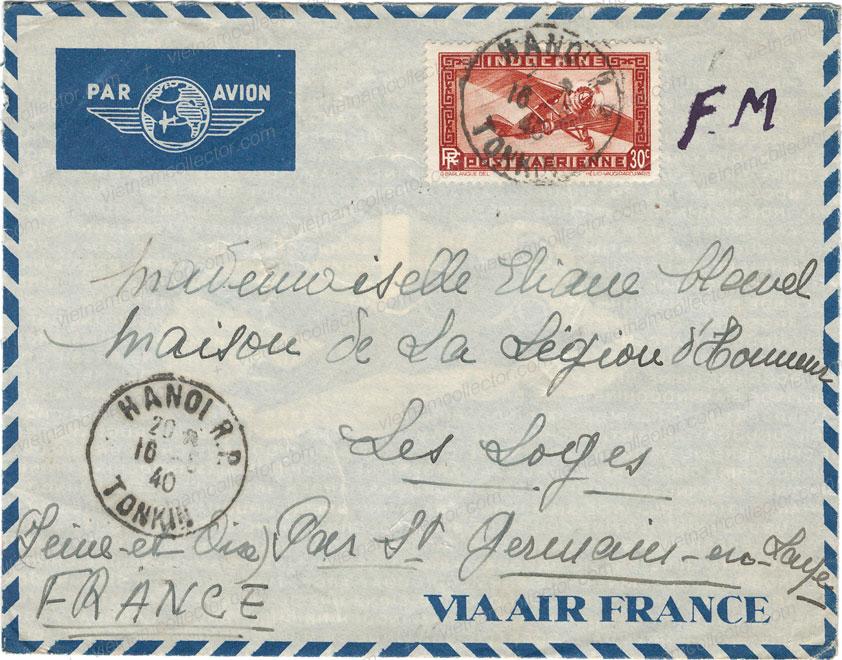 Single franking of the 30C value on a domestic official air mail letter sent by the Residence Superieure (Government Building) from Pnom Penh, Cambodia to France in November of 1936. Marseille machine arrival cancel on the reverse. Violet Government cachet on front.
Single franking of the 30C value on a domestic official air mail letter sent by the Residence Superieure (Government Building) from Pnom Penh, Cambodia to France in November of 1936. Marseille machine arrival cancel on the reverse. Violet Government cachet on front.
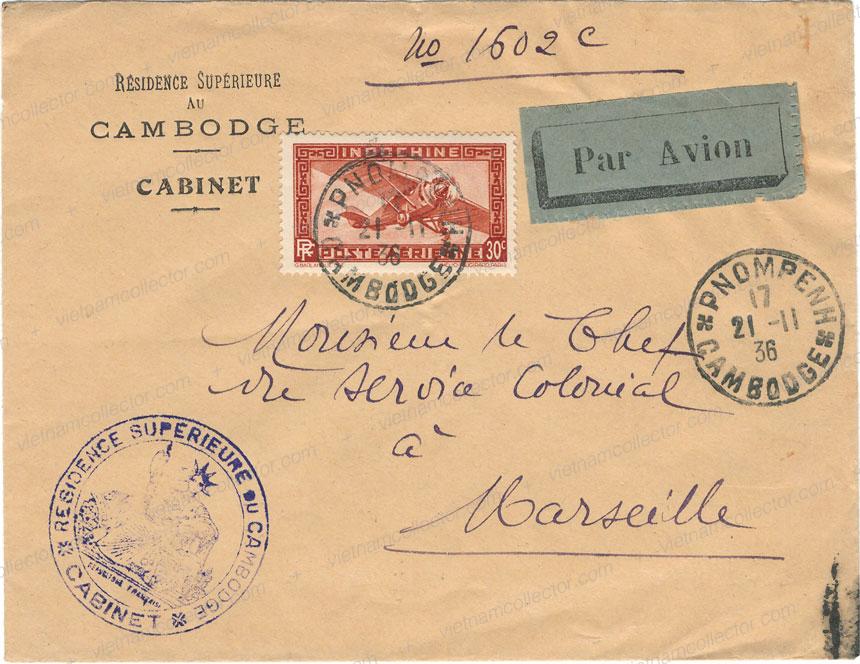
International letter sent in July of 1943 from Saigon to Penang in Malaysia. Properly franked with 40C made up of one of the overprint stamps of the Domestic Scene series plus a 30C Air Mail stamp. International letters during the Japanese occupation period are very rare. Malaysia was also occupied by the Japanese forces at that time so the letter was not censored.
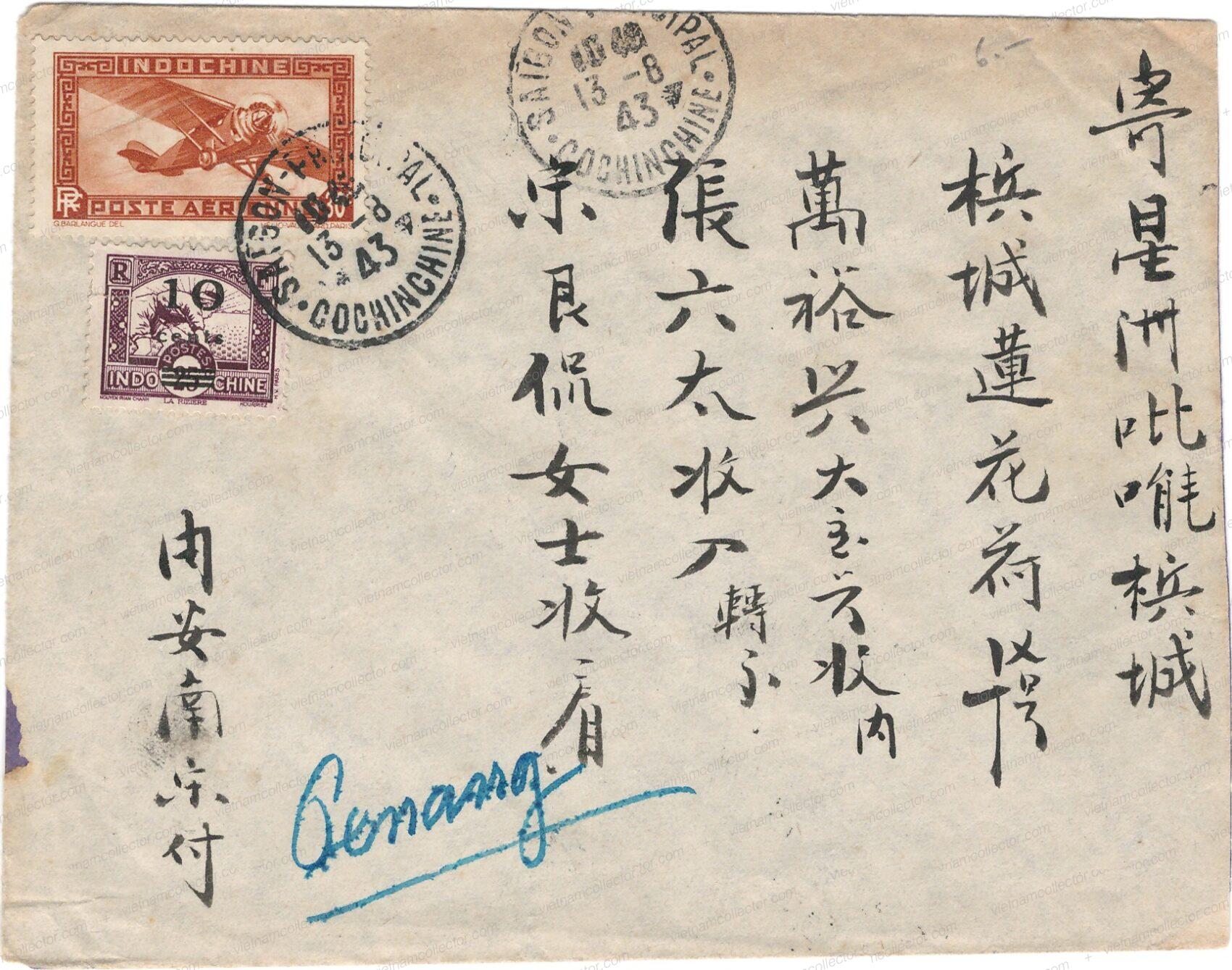
Single franking of the 36C Air Mail stamp on an international air mail letter sent in February of 1937 from Tourane to France. Saigon transfer cancel on the reverse.
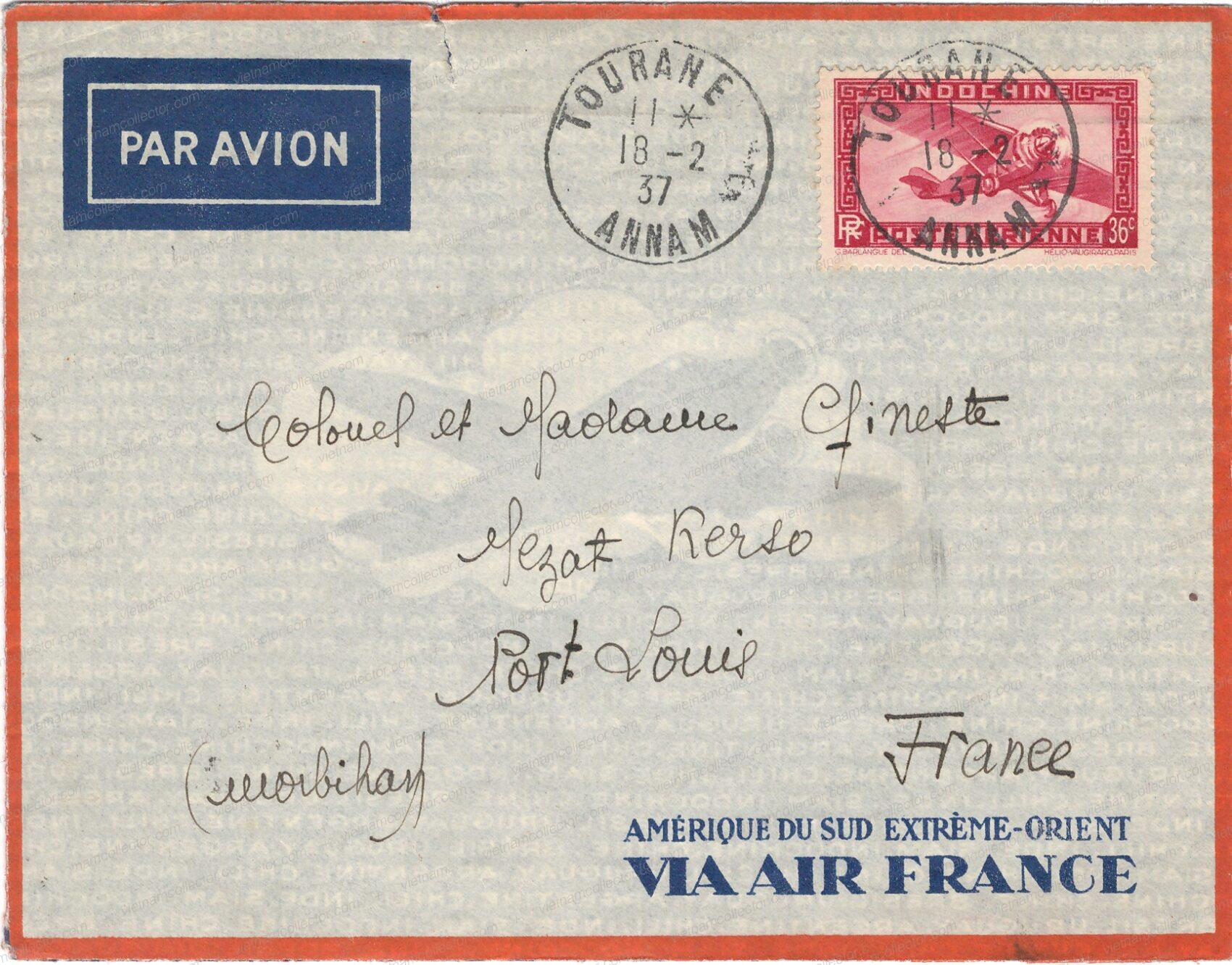
Single franking of the 36C Air Mail stamp combined with the cinderella advertising Vientiane in Laos on an international air mail letter sent from Phnom Penh, Cambodia to Lyon in France in November of 1933. Marseille transit and Lyon arrival cancels on the reverse.
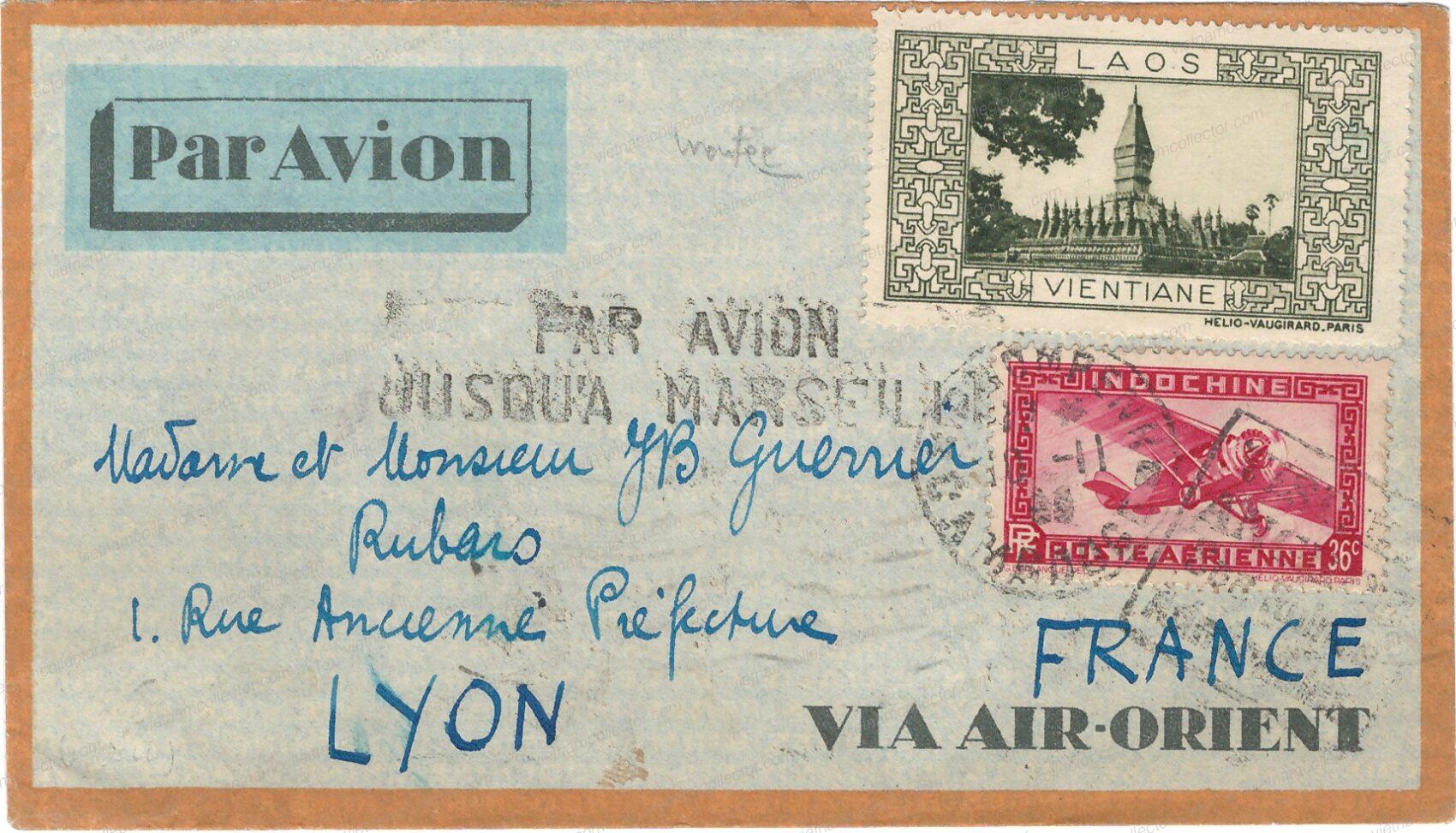
Mixed franking of the 30C and 36 C Air Mail stamps together with the 15C Domestic Scenes II stamp paying an overall postage of 81C on a registered international air mail letter sent from Campha-Mine (rare cancel) to France in December of 1937. Hai Phong transit and French arrival cancel on the reverse.
 Mixed franking of the 36C Air Mail stamp together with two 2C Domestic Scenes paying an overall postage of 40C on an international air mail letter (full contents preserved) sent from Vinh Long to India in July of 1935. Saigon transit and Indian arrival cancels on the reverse.
Mixed franking of the 36C Air Mail stamp together with two 2C Domestic Scenes paying an overall postage of 40C on an international air mail letter (full contents preserved) sent from Vinh Long to India in July of 1935. Saigon transit and Indian arrival cancels on the reverse.
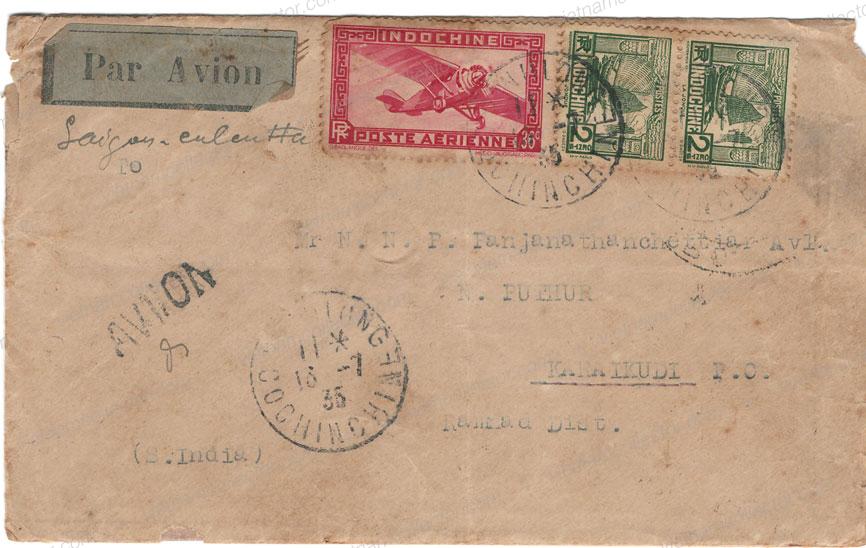
Single franking of the 36C stamp on an international air mail letter sent from Mytho to France in June of 1935. The tariff had gone up to 40C and as a result the letter received a “T”min a triangle indicating that additional postage was due upon arrival. This was paid by adding a 30C postage due stamp in Paris. Various Paris arrival cancels on the reverse.
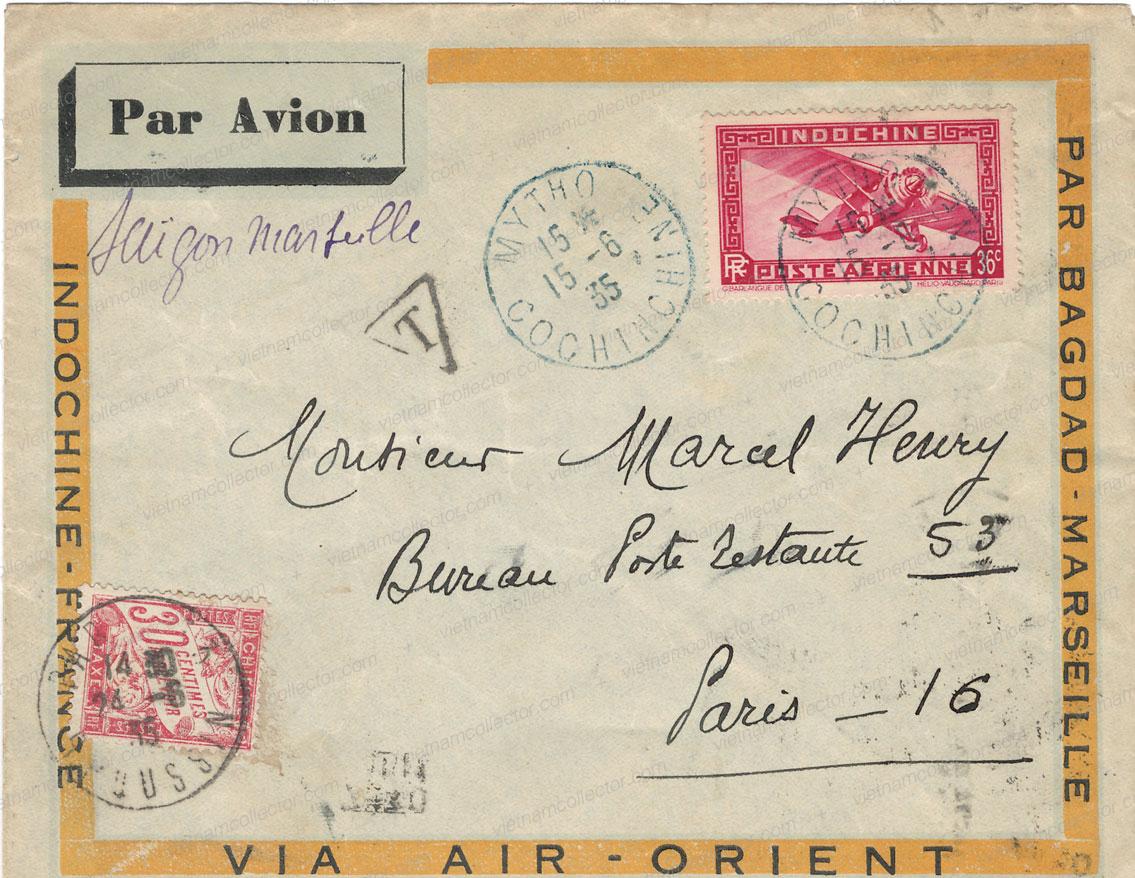
Postal stationary imprinted with the 36C air mail stamp on an international air mail letter sent from Siem Reap, Cambodia to France in November of 1934. The tariff had gone up to 40C and as a result the letter was charged with a 30C P{stage Due stamp on arrival. Pnom Penh transit and Marseille arrival cancels on the reverse.
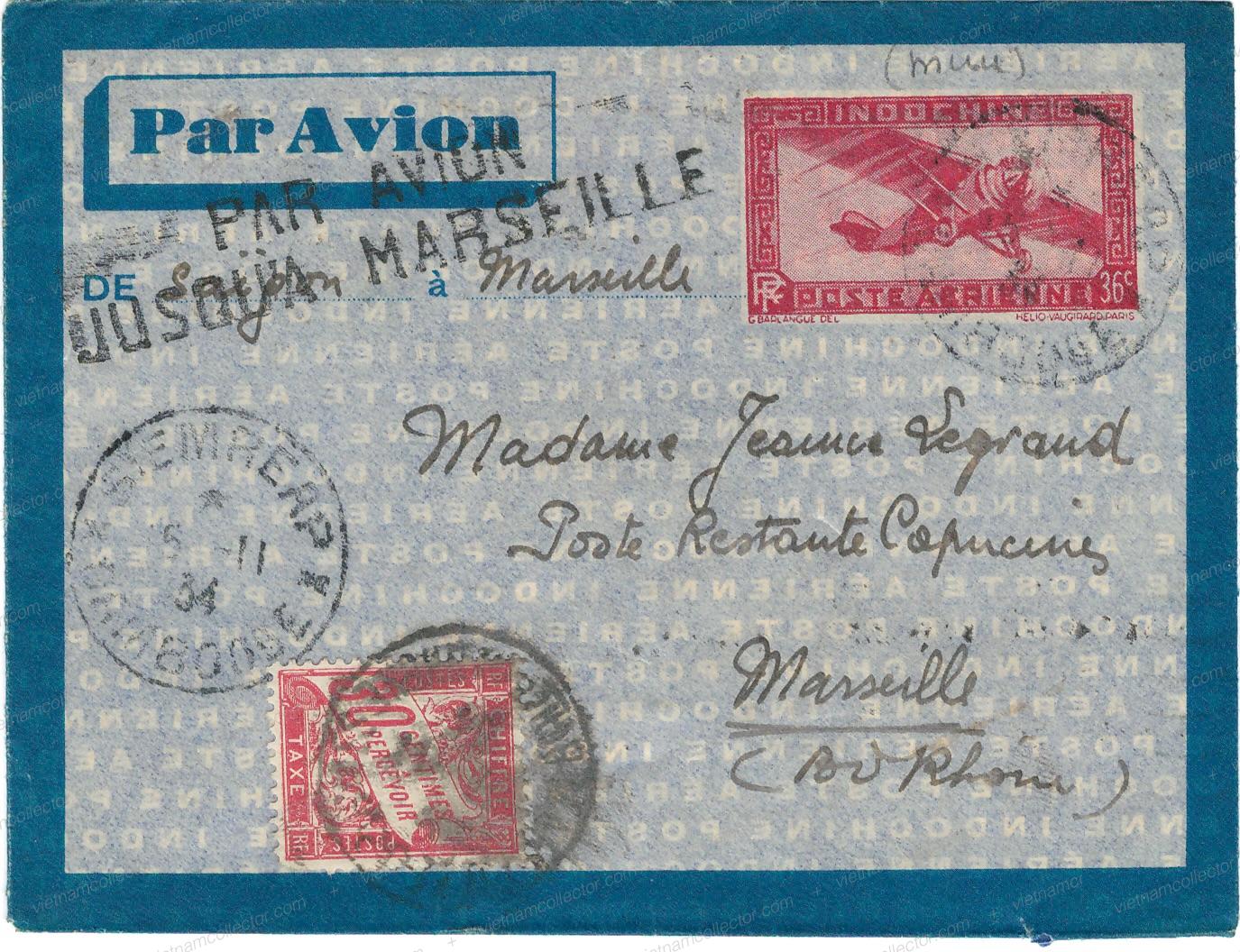
Single franking of the 36C stamp on an international air mail letter sent from Cape Saint Jaques (Vung Tau) to France in June of 1934. Back oval cachet “From the Post Box” cachet in front. This was applied to alert the postal clerks that the postage of these letters had to be checked prior to processing. Saigon transit and French machine arrival cancel on the reverse.
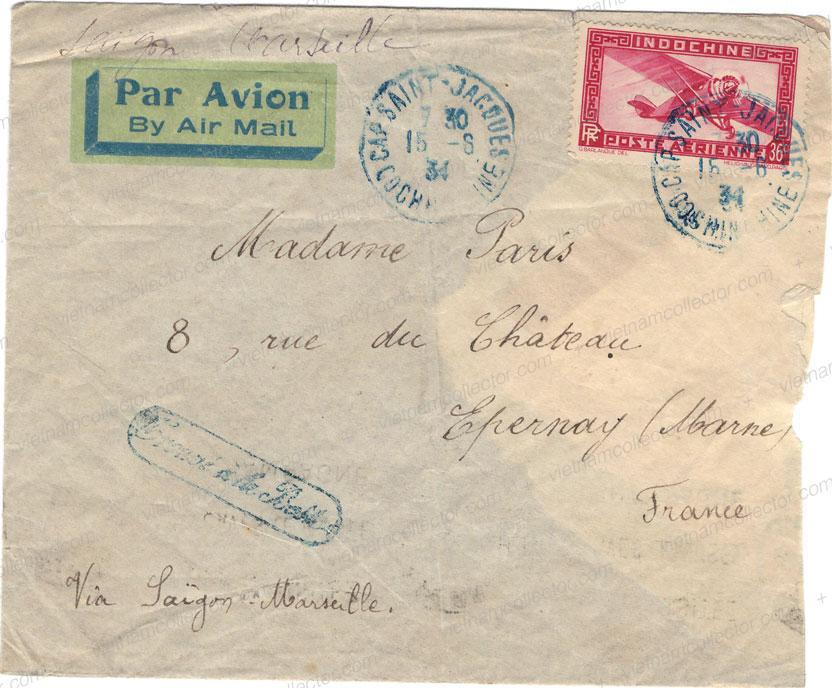 Single franking of the 36C stamp on an international air mail letter sent from the prison island of Paulo Condore (rare cancel) to France in August of 1938. Paris machine arrival cancel on the reverse.
Single franking of the 36C stamp on an international air mail letter sent from the prison island of Paulo Condore (rare cancel) to France in August of 1938. Paris machine arrival cancel on the reverse.
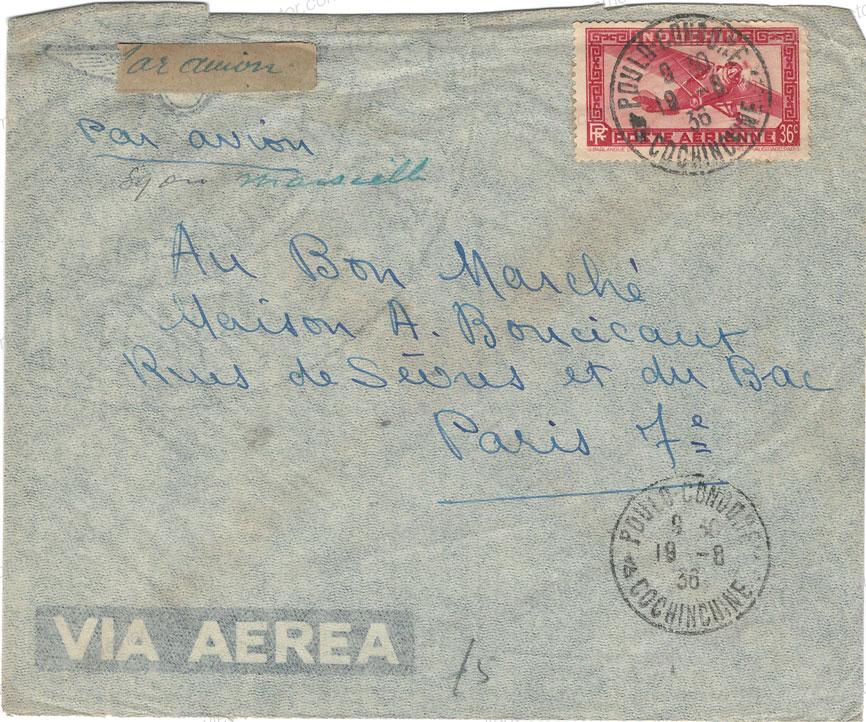 Postal stationary of the 36C stamp (11.7×8.7cm) up-franked with the 1C Domestic Scenes stamp paying an overall postage of 37C sent from Tour-Cham (rare cancel) to France in December of 1938.
Postal stationary of the 36C stamp (11.7×8.7cm) up-franked with the 1C Domestic Scenes stamp paying an overall postage of 37C sent from Tour-Cham (rare cancel) to France in December of 1938.
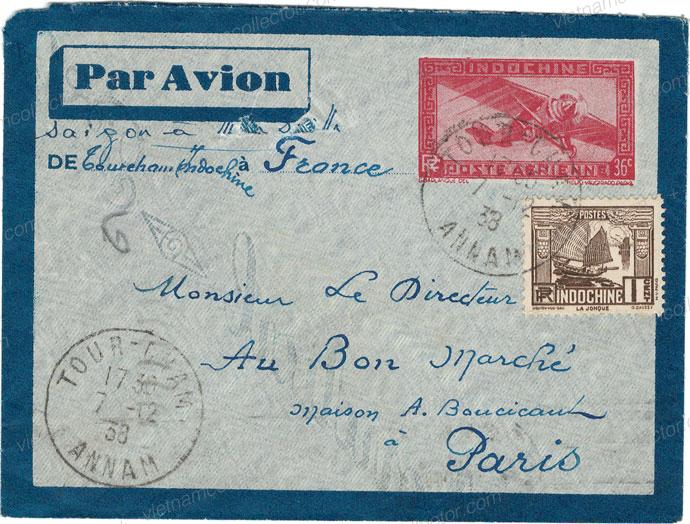 Postal stationary of the 36C stamp (11.7×8.7cm) up-franked with the 3C, 7C and 30C Domestic Scenes stamps paying an overall postage of 83C sent to Switzerland in November of 1939. This was only two months after the start of World War 2 which is why the letter was censored by the French military as indicated by the circular “Controls Postal” and various other censure cachets on front and back and the military banderole that was used to re-seal the letter. Circular B3 censor stamp was used in Annam (Desrousseaux, SICP Journal Nr. 11, April 1973). Hue and Hanoi transit cancels on the reverse.
Postal stationary of the 36C stamp (11.7×8.7cm) up-franked with the 3C, 7C and 30C Domestic Scenes stamps paying an overall postage of 83C sent to Switzerland in November of 1939. This was only two months after the start of World War 2 which is why the letter was censored by the French military as indicated by the circular “Controls Postal” and various other censure cachets on front and back and the military banderole that was used to re-seal the letter. Circular B3 censor stamp was used in Annam (Desrousseaux, SICP Journal Nr. 11, April 1973). Hue and Hanoi transit cancels on the reverse.
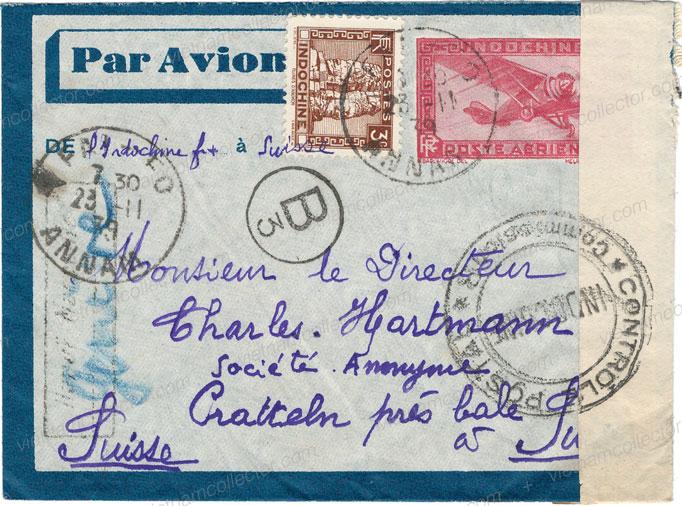
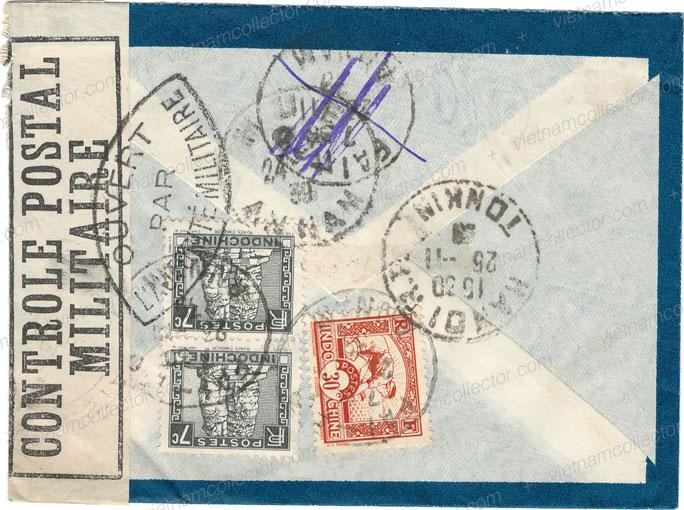 Registered postal stationary of the 36C stamp (11.7×8.7cm) up-franked with the 4C and 20C Domestic Scenes stamps paying an overall postage of 60C sent from Saigon to France in June of 1940. This was at a time when the South of France was dominated by the Vichy Regime that was aligned with the German occupiers and which is why the letter was censored by the French military as indicated by the circular “Controls Postal” and various other censure cachets on front and back and the military banderole that was used to re-seal the letter. Circular C6 censor stamp was used in Saigon (Desrousseaux, SICP Journal Nr. 11, April 1973). Hue and Hanoi transit cancels on the reverse. Black bar cachet “Vise par la Douane” on the reverse.
Registered postal stationary of the 36C stamp (11.7×8.7cm) up-franked with the 4C and 20C Domestic Scenes stamps paying an overall postage of 60C sent from Saigon to France in June of 1940. This was at a time when the South of France was dominated by the Vichy Regime that was aligned with the German occupiers and which is why the letter was censored by the French military as indicated by the circular “Controls Postal” and various other censure cachets on front and back and the military banderole that was used to re-seal the letter. Circular C6 censor stamp was used in Saigon (Desrousseaux, SICP Journal Nr. 11, April 1973). Hue and Hanoi transit cancels on the reverse. Black bar cachet “Vise par la Douane” on the reverse.
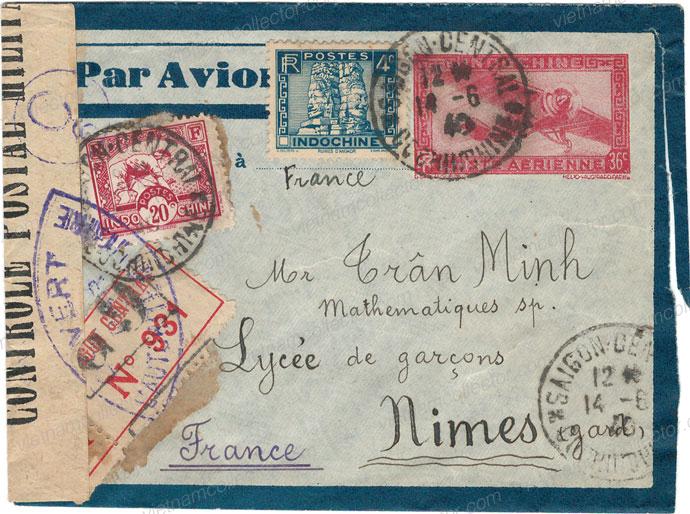
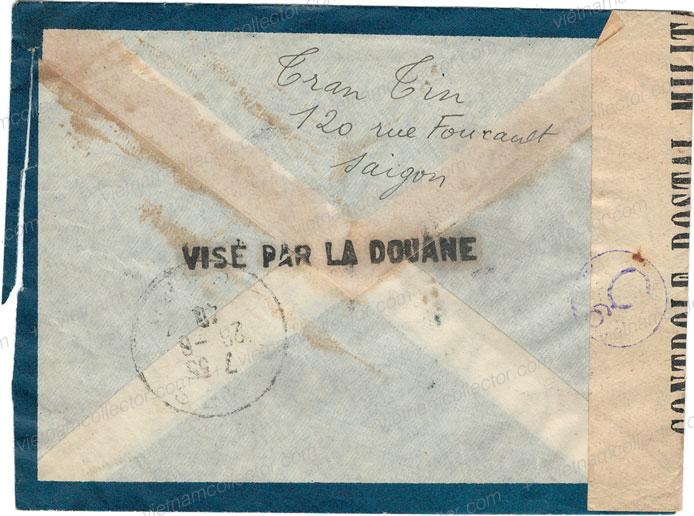
Mixed franking of the 37C Air Mail stamp together with the 1C Domestic Scenes II set paying an overall postage of 38C on a First Flight Cover inaugurating the flight Saigon to Hong Kong on October 5th, 1938. First Flight cachet on front.
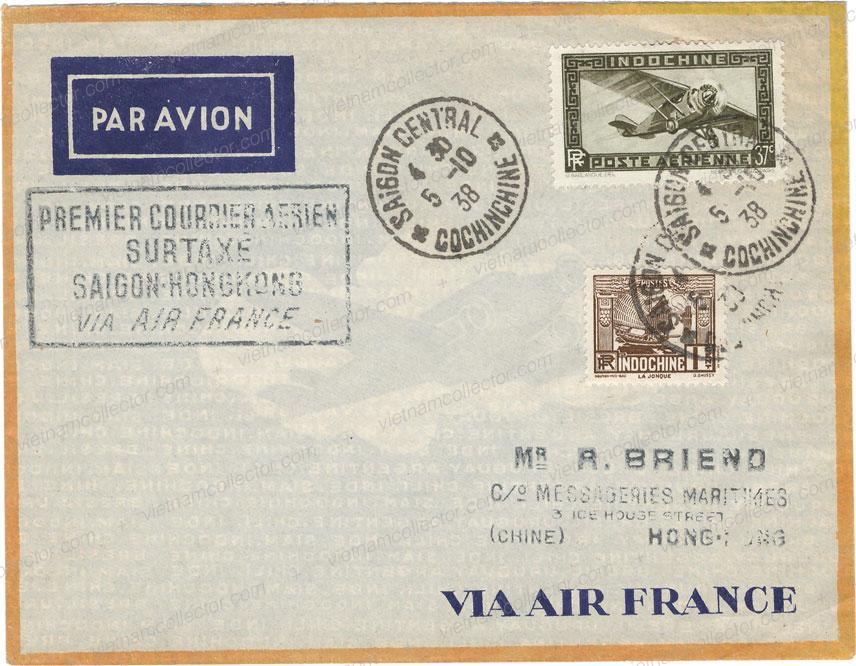
Mixed franking of the 2P Kingdom Annam value together with stamps from the Domestic Scenes II and Air Mail sets paying an overall postage of 3.20P on a International letter sent by the Bank of Indochina in Hanoi in September of 1940 to a branch in Vichy. All three stamps carry the Bank of Indochina perrin that was applied to protect from internal theft. This was during World Was II which meant that the letter was subject to censure. However, the bank enjoyed special privileges that exempted it from such censure inside Indochina which was indicated by a red cachet struck in front that read “Banque Privilegied a expedier sans delai Exempt de Censure”. However, the privilege did not extend to other countries and so the letter was censured by the British in Hong Kong as indicted by the black and white censure tape.
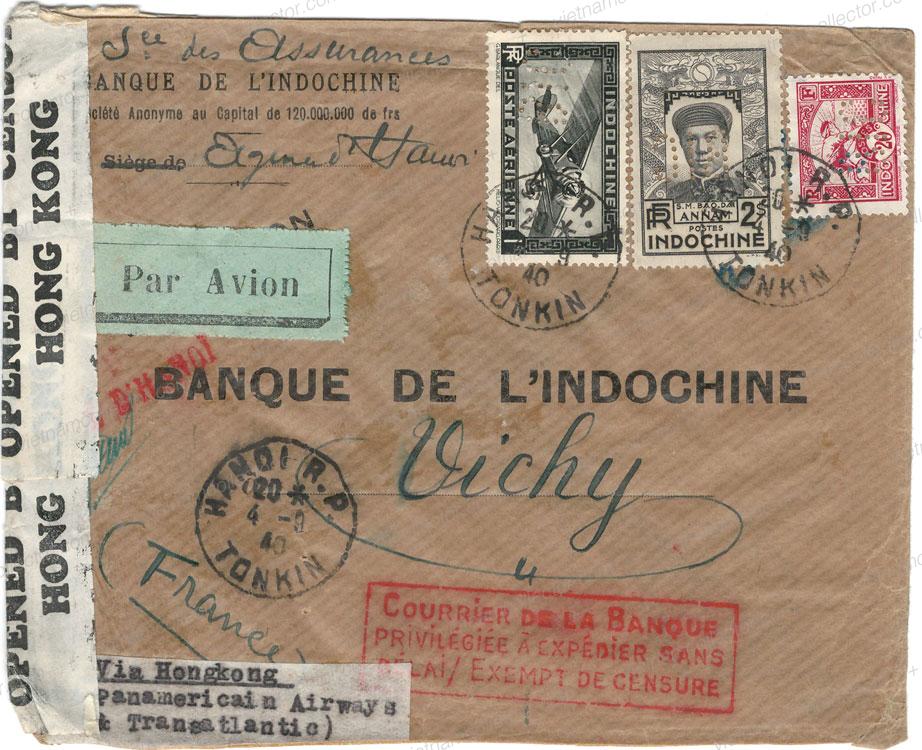
Mixed franking of the 4C Domestic Scenes II stamp together with the 37C Air Mail stamp paying an overall postage of 43C on an international air mail letter sent from Saigon to India in April of 1939. Indian arrival cancels on the reverse.
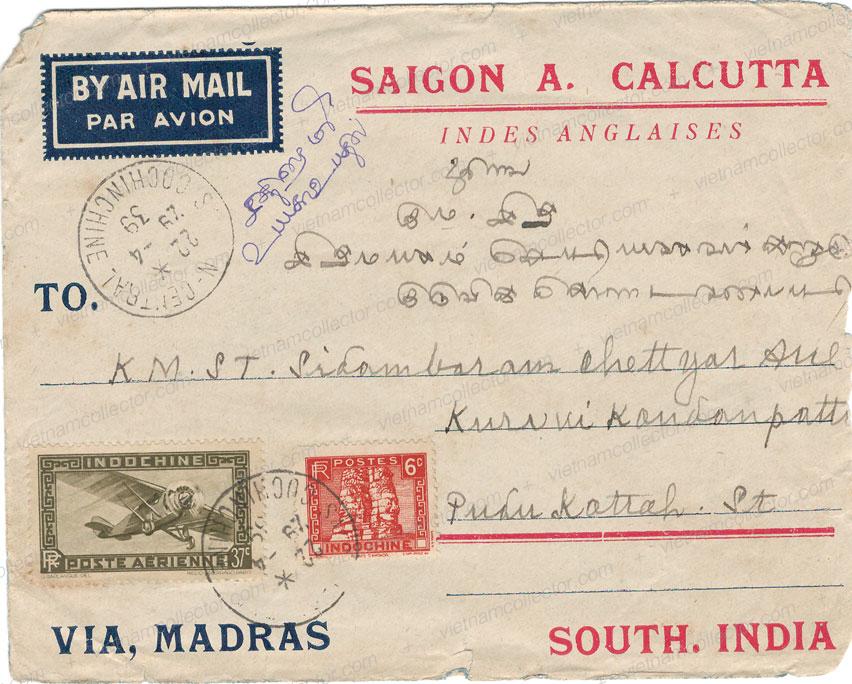 Mixed franking of the 1C Domestic Scenes II stamp together with the 37C Air Mail stamp paying an overall postage of 38C on a registered international air mail letter sent from Gia Dinh to India in July of 1938. Saigon transit and Indian arrival cancels on the reverse.
Mixed franking of the 1C Domestic Scenes II stamp together with the 37C Air Mail stamp paying an overall postage of 38C on a registered international air mail letter sent from Gia Dinh to India in July of 1938. Saigon transit and Indian arrival cancels on the reverse.
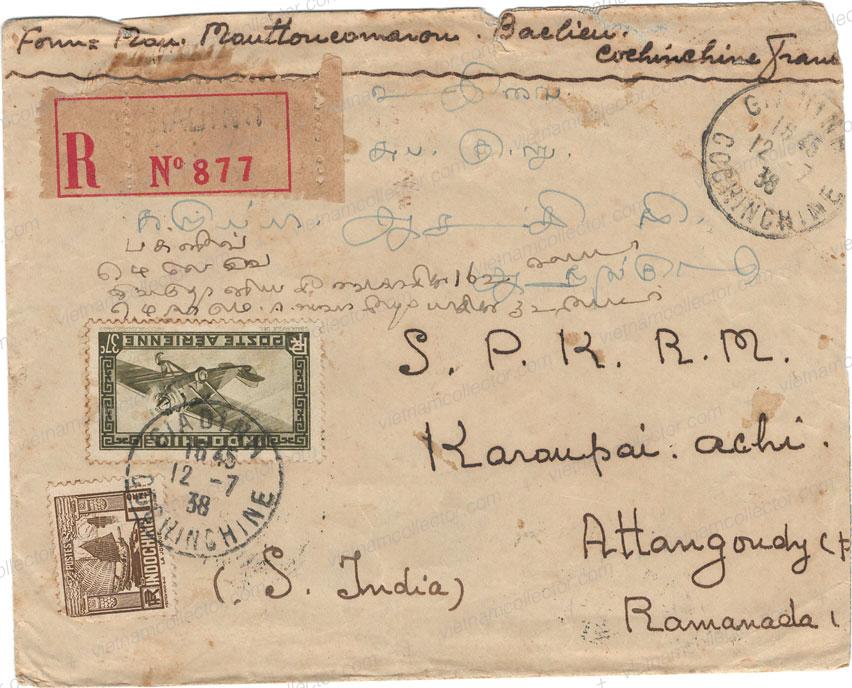 Mixed franking of the 8C Domestic Scenes II stamp together with the 60C Air Mail stamp paying an overall postage of 68C on an international air mail letter sent from Saigon to India in May of 1939. Indian arrival cancels on the reverse.
Mixed franking of the 8C Domestic Scenes II stamp together with the 60C Air Mail stamp paying an overall postage of 68C on an international air mail letter sent from Saigon to India in May of 1939. Indian arrival cancels on the reverse.
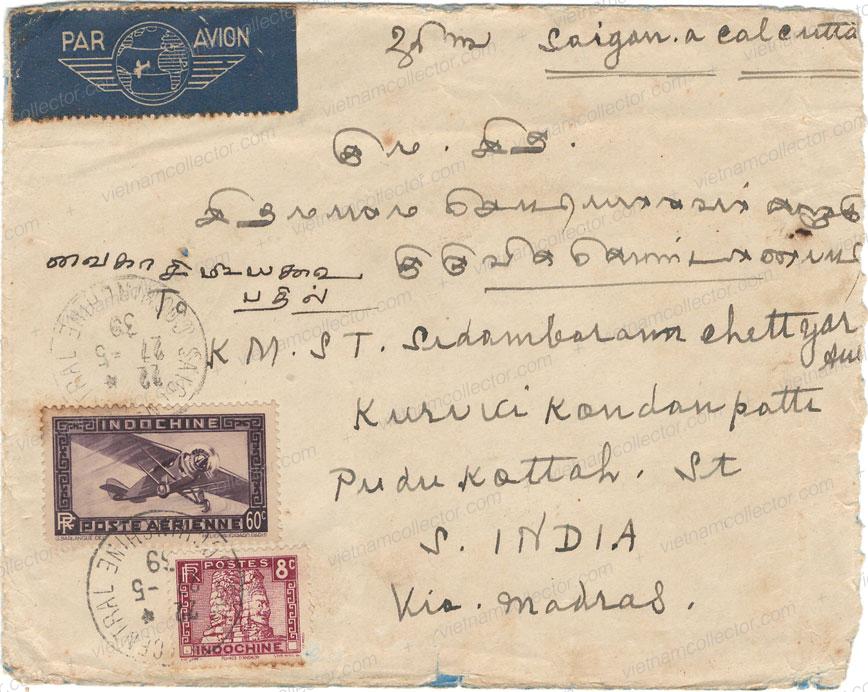 Mixed franking of the 20C Domestic Scenes II stamp together with the 60C Air Mail stamp paying an overall postage of 80C on an international air mail letter sent from Saigon to France.
Mixed franking of the 20C Domestic Scenes II stamp together with the 60C Air Mail stamp paying an overall postage of 80C on an international air mail letter sent from Saigon to France.
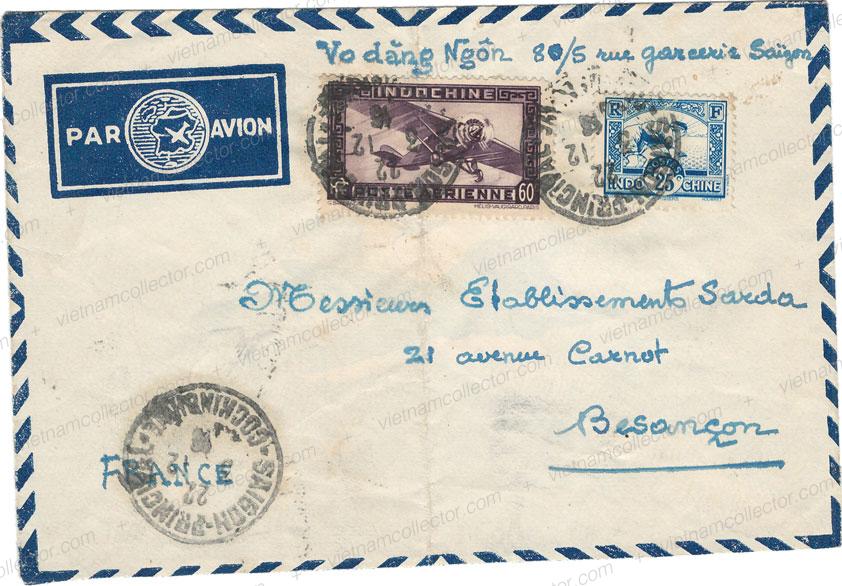 Multiple franking of the 60C value (2) paying an overall postage f 1.20P on an international air mail letter sent from Saigon to France in June of 1947.
Multiple franking of the 60C value (2) paying an overall postage f 1.20P on an international air mail letter sent from Saigon to France in June of 1947.
 Mixed franking of the 70C Domestic Scenes II stamp together with the 60C Air Mail stamp paying an overall postage of 1.30C on an international air mail letter sent from Saigon to India in May of 1947. Indian arrival cancels on the reverse.
Mixed franking of the 70C Domestic Scenes II stamp together with the 60C Air Mail stamp paying an overall postage of 1.30C on an international air mail letter sent from Saigon to India in May of 1947. Indian arrival cancels on the reverse.
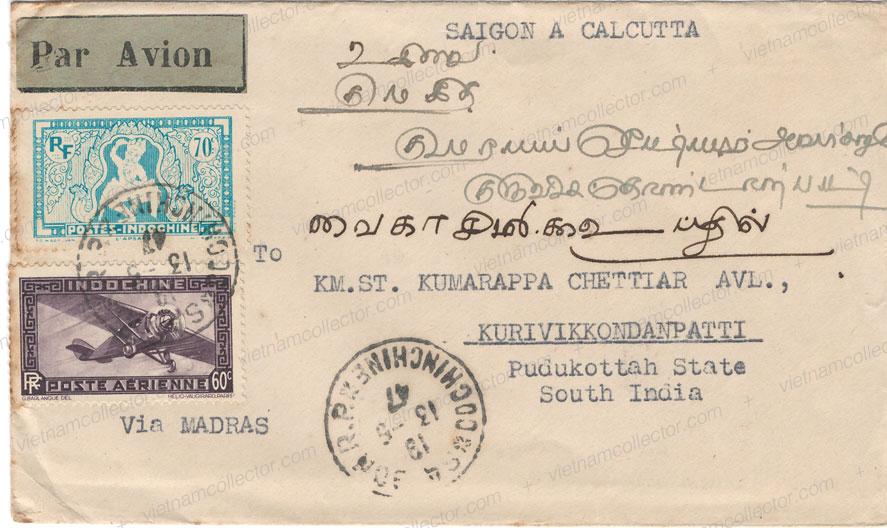
Mixed franking of the 20C Seafarer stamp together with stamps from the Air Mail and Personalties sets paying an overall postage of 85C on an international air mail letter sent from Saigon to Algeria in January of 1945. The letter was censored by the Japanese Occupation Force as indicated by the French banderole and censor hand stamps that the Japanese continued to use. International letter sent during the Japanese Occupation are very rare.

Single franking of the 66C stamp on an international letter sent by the Banque de l’indochina in Tourane (Da Nang) to their branch in Paris, France sent in December of 1933. Saigon transit and Paris arrival cancels on the reverse.
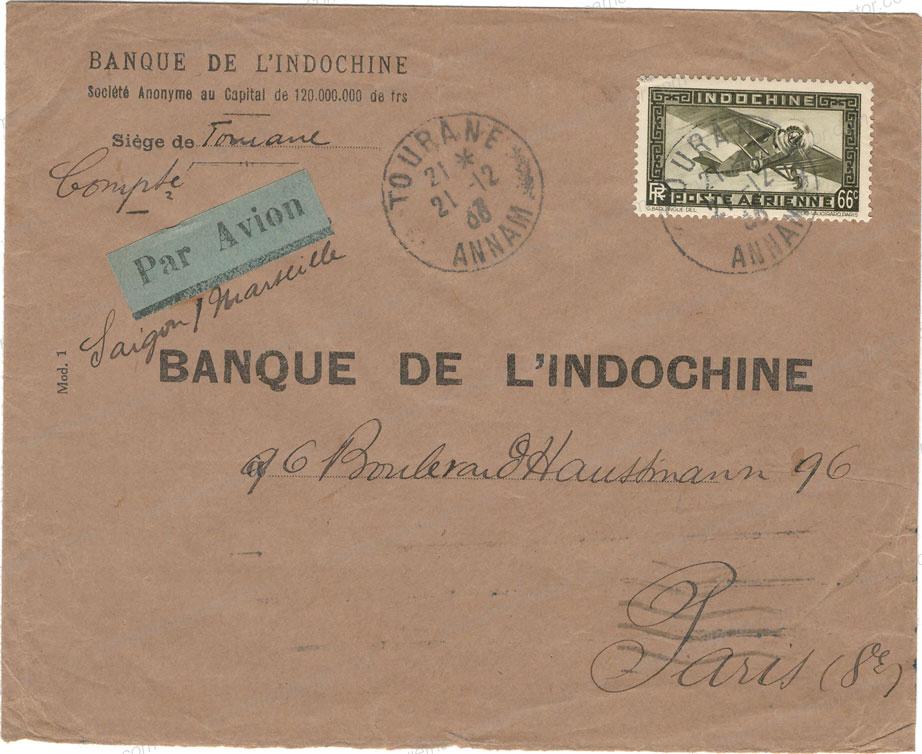
Single franking of the 66C Air Mail stamp on an international air mail letter sent in June of 1937 from Hanoi to France. Marseille Gare transfer and Toulon arrival cancel on the reverse.
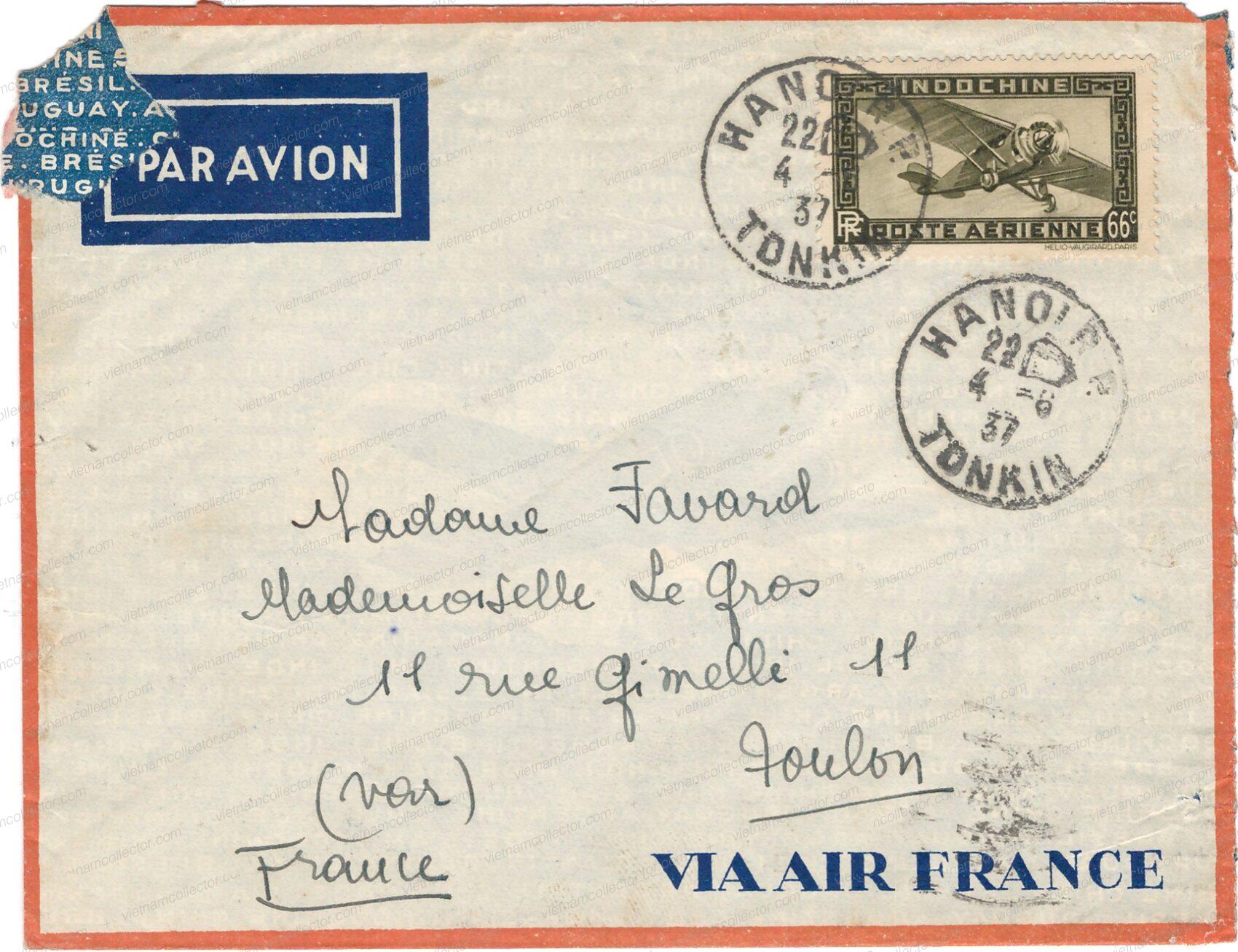
Mixed franking of the 7C Domestic Scenes II stamps together with the 66C Air Mail stamps paying an overall postage of 1.50P on an international air mail letter sent from Pnom Penh, Cambodia to France in March of 1948.
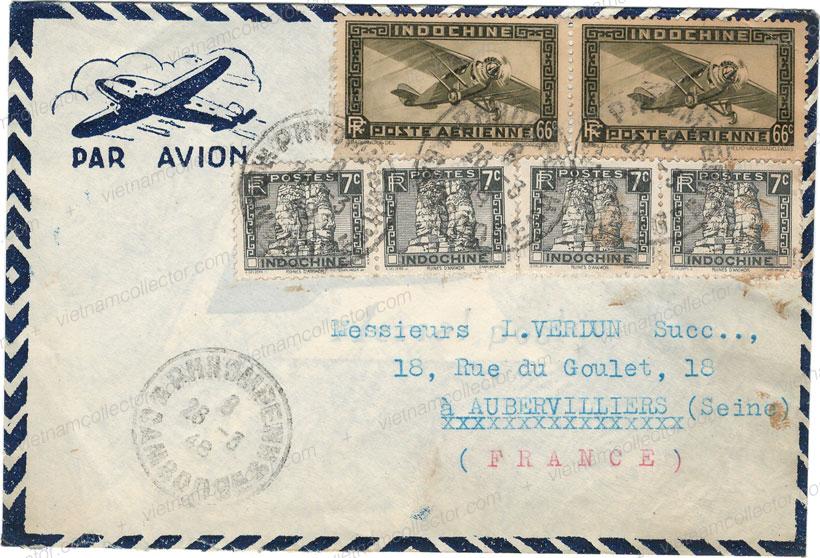 Mixed franking of the 20C, 30C, 1P and 2P Domestic Scenes II stamps together with the 66C Air Mail and 37C Indochinese Railway stamps paying an overall postage of 6.46P on a domestic air mail letter (full contents preserved) sent from Pursat (rare cancel) in Cambodia to a member of the military through BPM 518 in June of 1948. Mute “Poste aux Armees” arrival cancel on the reverse.
Mixed franking of the 20C, 30C, 1P and 2P Domestic Scenes II stamps together with the 66C Air Mail and 37C Indochinese Railway stamps paying an overall postage of 6.46P on a domestic air mail letter (full contents preserved) sent from Pursat (rare cancel) in Cambodia to a member of the military through BPM 518 in June of 1948. Mute “Poste aux Armees” arrival cancel on the reverse.
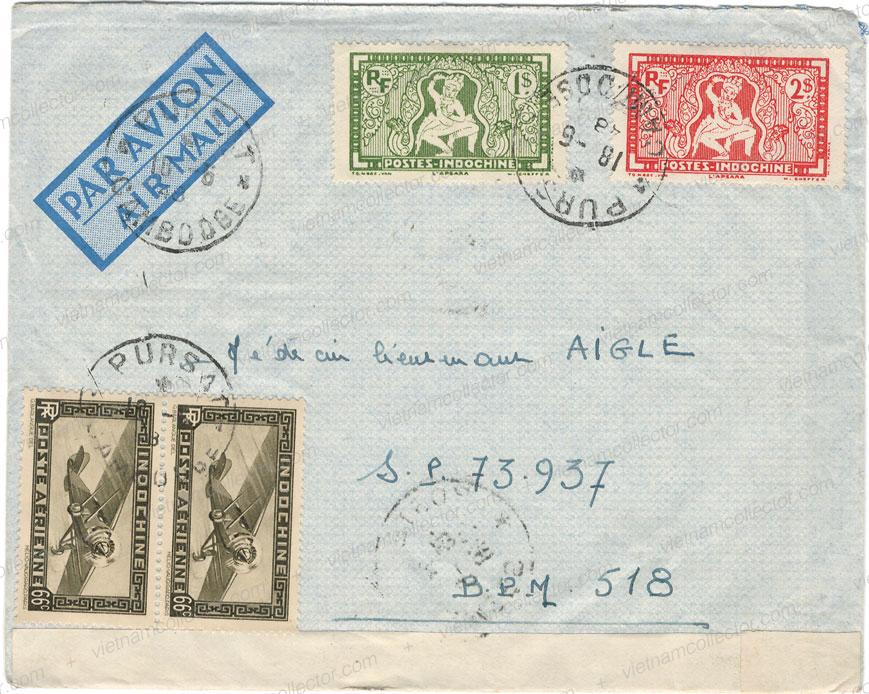
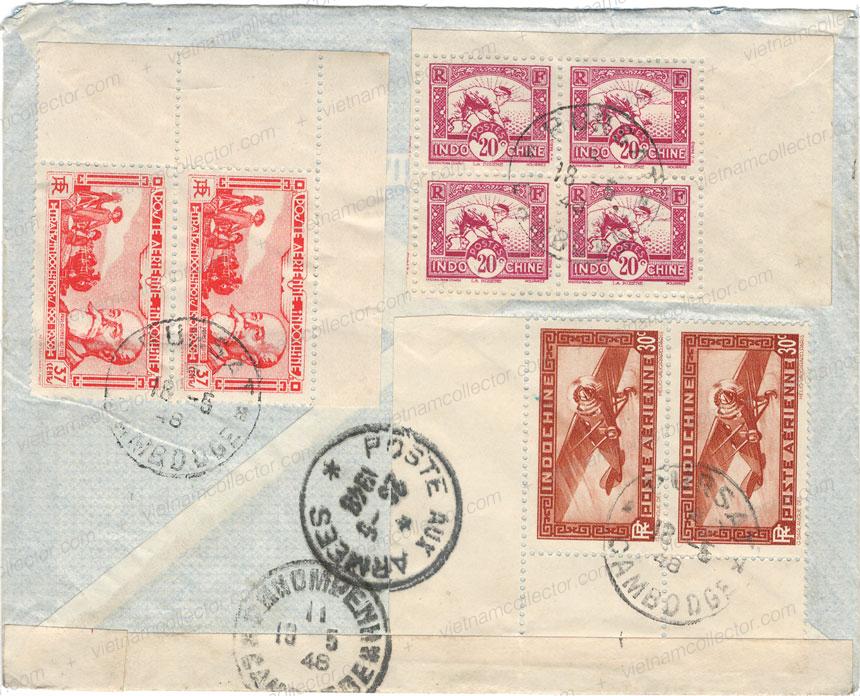 Single franking of the 1P value on an official international letter sent by the Residence Superieure (Government Building) in Vientiane, Laos to the Colonial Office in France in November of 1938. Red circular Government cachet on front. Hanoi transit and Marseille machine arrival cancels on the reverse.
Single franking of the 1P value on an official international letter sent by the Residence Superieure (Government Building) in Vientiane, Laos to the Colonial Office in France in November of 1938. Red circular Government cachet on front. Hanoi transit and Marseille machine arrival cancels on the reverse.
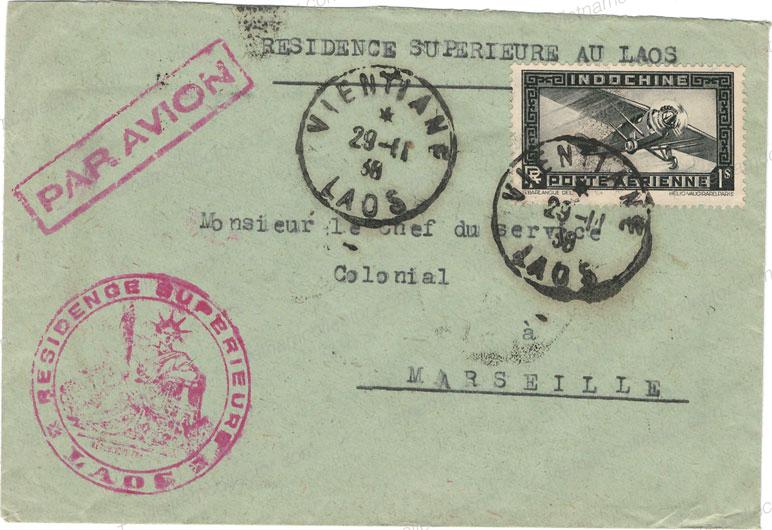 Mixed franking of the 10C (blue on rose) and 60C Domestic Scenes II stamps together with the 1P Air Mail stamp paying an overall postage of 3.60P on an international air mail letter sent from Hanoi to France in September of 1949.
Mixed franking of the 10C (blue on rose) and 60C Domestic Scenes II stamps together with the 1P Air Mail stamp paying an overall postage of 3.60P on an international air mail letter sent from Hanoi to France in September of 1949.
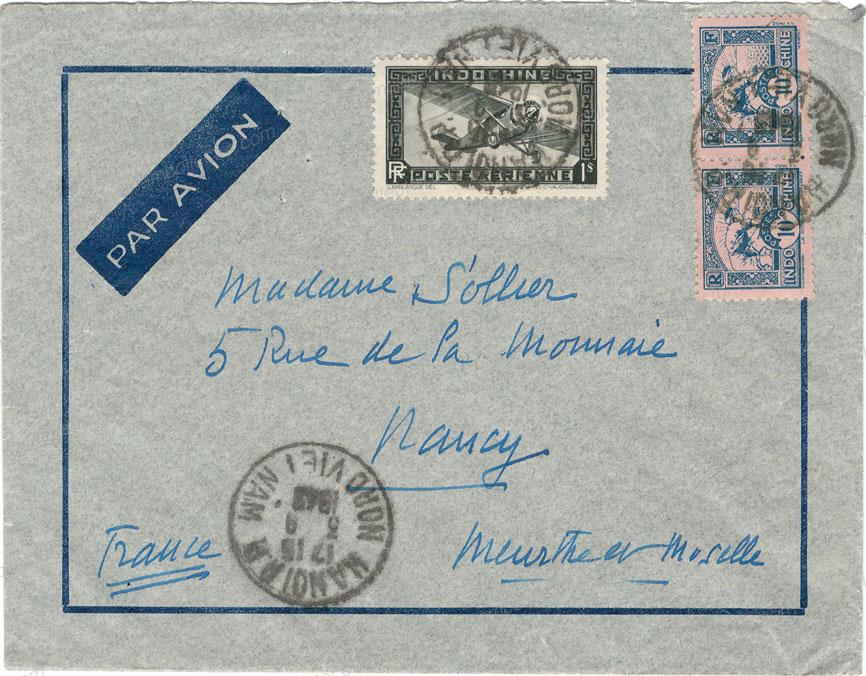
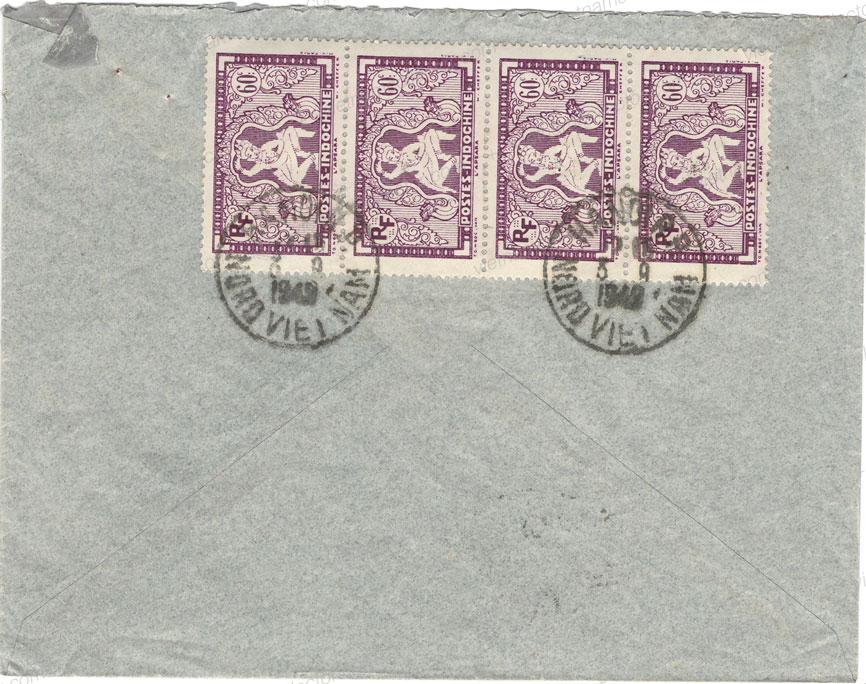 Mixed franking of the 70C Domestic Scenes II stamp together with the 1P Air Mail stamp paying an overall postage of 1.70P on an international air mail letter sent from Saigon to France in January of 1947.
Mixed franking of the 70C Domestic Scenes II stamp together with the 1P Air Mail stamp paying an overall postage of 1.70P on an international air mail letter sent from Saigon to France in January of 1947.
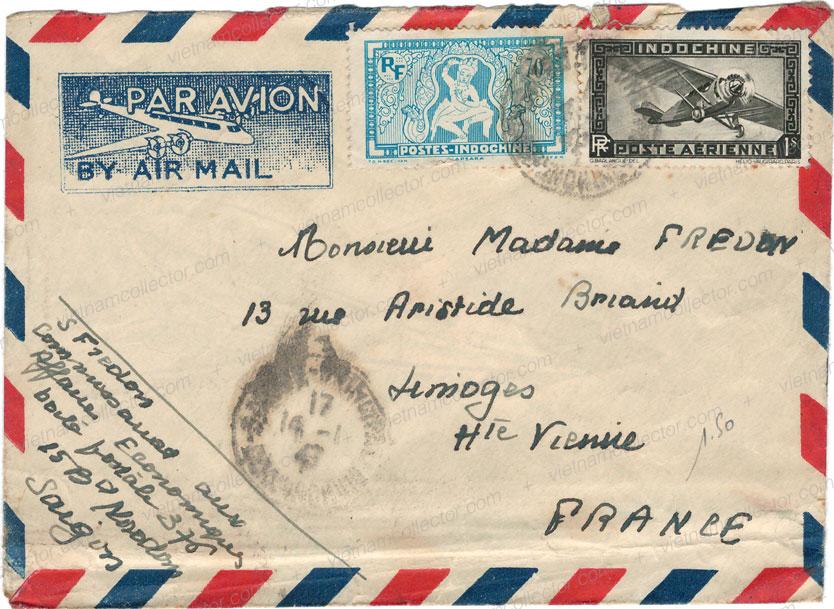 Mixed franking of the 20C Domestic Scenes II stamps together with the 1P Air Mail stamp paying an overall postage of 1.20P on an international air mail letter sent from Saigon to India in September of 1947. Indian arrival cancels on the reverse.
Mixed franking of the 20C Domestic Scenes II stamps together with the 1P Air Mail stamp paying an overall postage of 1.20P on an international air mail letter sent from Saigon to India in September of 1947. Indian arrival cancels on the reverse.
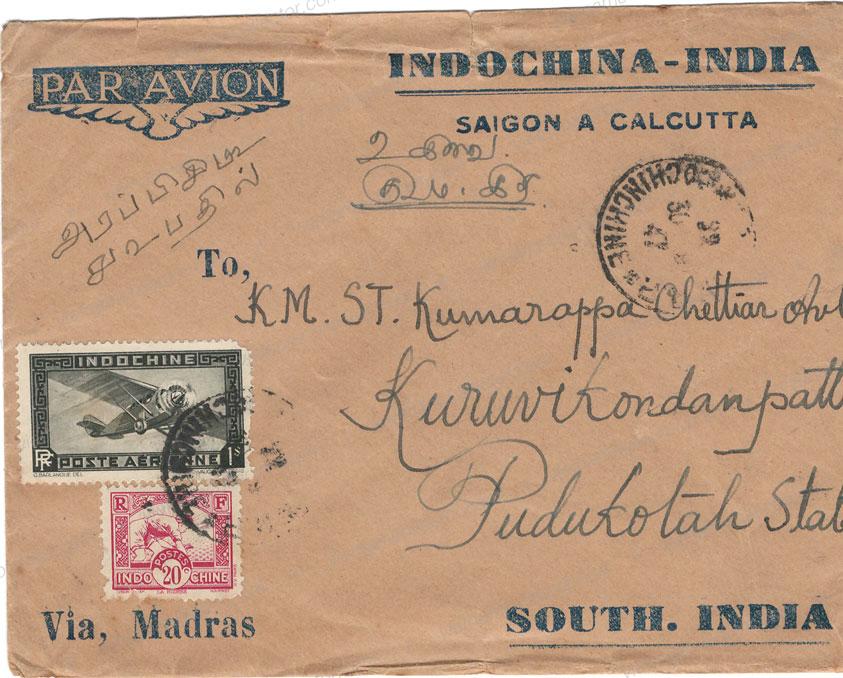 Mixed franking of the 20C Domestic Scenes II stamps together with the 1P Air Mail stamp paying an overall postage of 1.20P on an international air mail letter sent from Hanoi to France in May of 1947.
Mixed franking of the 20C Domestic Scenes II stamps together with the 1P Air Mail stamp paying an overall postage of 1.20P on an international air mail letter sent from Hanoi to France in May of 1947.
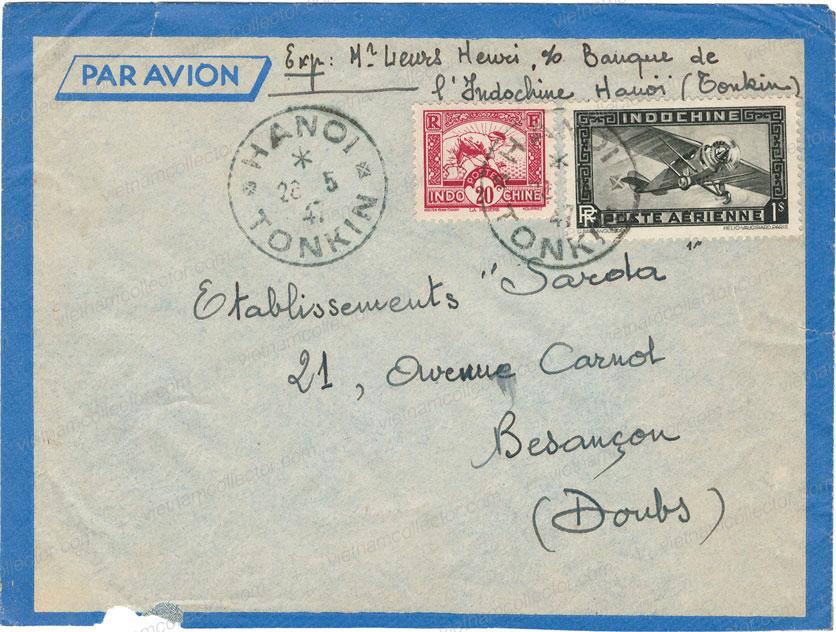 Single franking of the 1P stamp on an international air mail letter sent from Saigon to India.
Single franking of the 1P stamp on an international air mail letter sent from Saigon to India.
 Single franking of the 1P stamp on an international air mail letter sent from Saigon to India in June of 1947. Indian arrival cancel on the reverse.
Single franking of the 1P stamp on an international air mail letter sent from Saigon to India in June of 1947. Indian arrival cancel on the reverse.
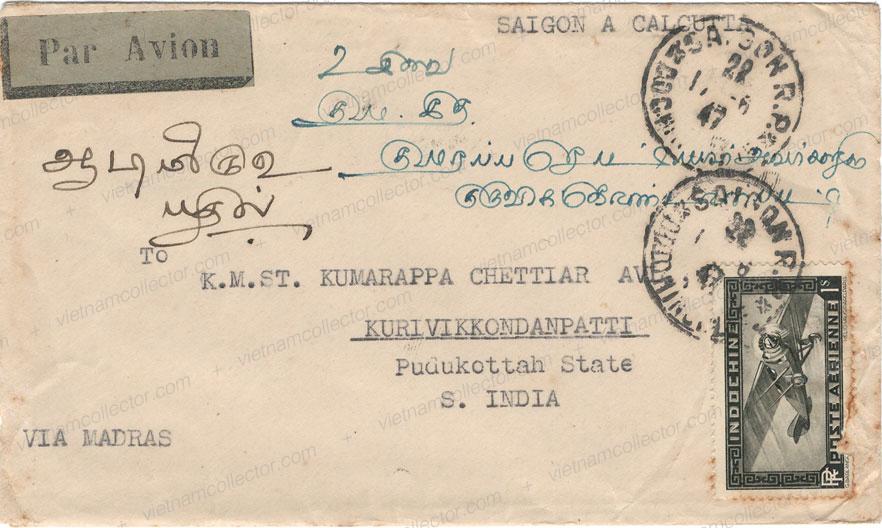 Mixed franking of the 10C (blue on rose) and 20C Domestic Scenes II stamps together with the 1P Air Mail stamps paying an overall postage of 2.40P on an international air mail letter sent from Faifoo (rare cancel) to France in October of 1950. The letter was judged to be under-paid so a black “T” hand stamp was applied to indict that additional postage was due upon arrival. A French 20F postage due stamp was added in order to collect the additional postage. Tourane transit cancel on the reverse.
Mixed franking of the 10C (blue on rose) and 20C Domestic Scenes II stamps together with the 1P Air Mail stamps paying an overall postage of 2.40P on an international air mail letter sent from Faifoo (rare cancel) to France in October of 1950. The letter was judged to be under-paid so a black “T” hand stamp was applied to indict that additional postage was due upon arrival. A French 20F postage due stamp was added in order to collect the additional postage. Tourane transit cancel on the reverse.
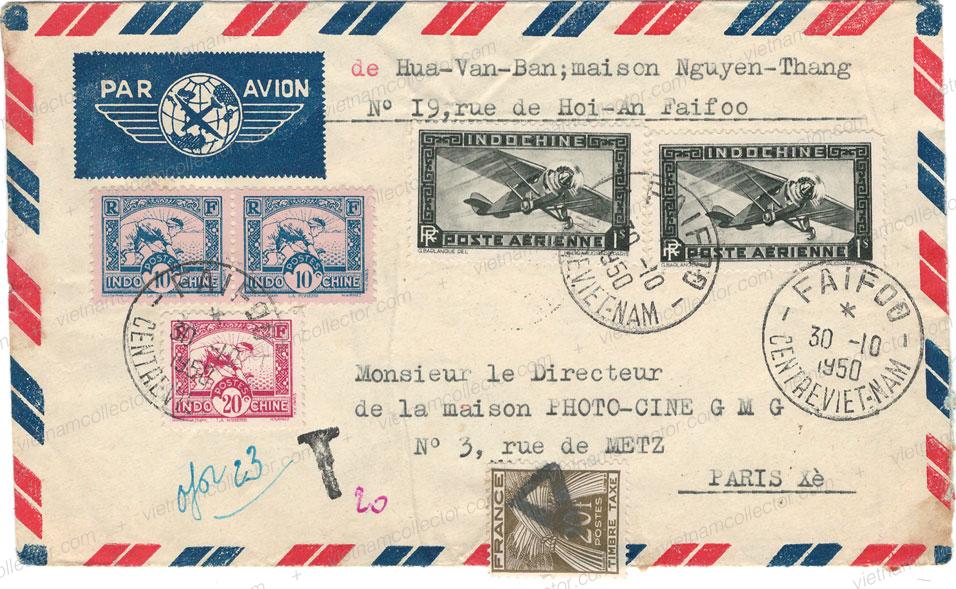 Mixed franking of the 70C Domestic Scenes II stamps (2) together with the 1P Air Mail stamp paying an overall postage of 2.40P on an international air mail letter sent from Saigon to India in August of 1949. Indian arrival cancels on the reverse.
Mixed franking of the 70C Domestic Scenes II stamps (2) together with the 1P Air Mail stamp paying an overall postage of 2.40P on an international air mail letter sent from Saigon to India in August of 1949. Indian arrival cancels on the reverse.
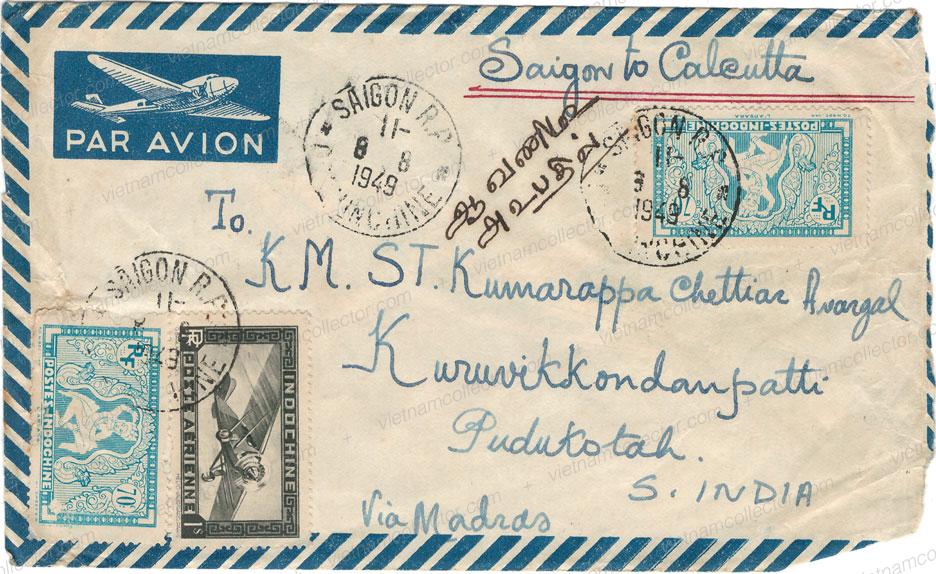 Mixed franking of the 20C Domestic Scenes II stamps together with the 1P Air Mail stamp paying an overall postage of 1.20P on an international air mail letter sent from Hai Phong to France in September of 1947. Hanoi transit cancel on the reverse.
Mixed franking of the 20C Domestic Scenes II stamps together with the 1P Air Mail stamp paying an overall postage of 1.20P on an international air mail letter sent from Hai Phong to France in September of 1947. Hanoi transit cancel on the reverse.
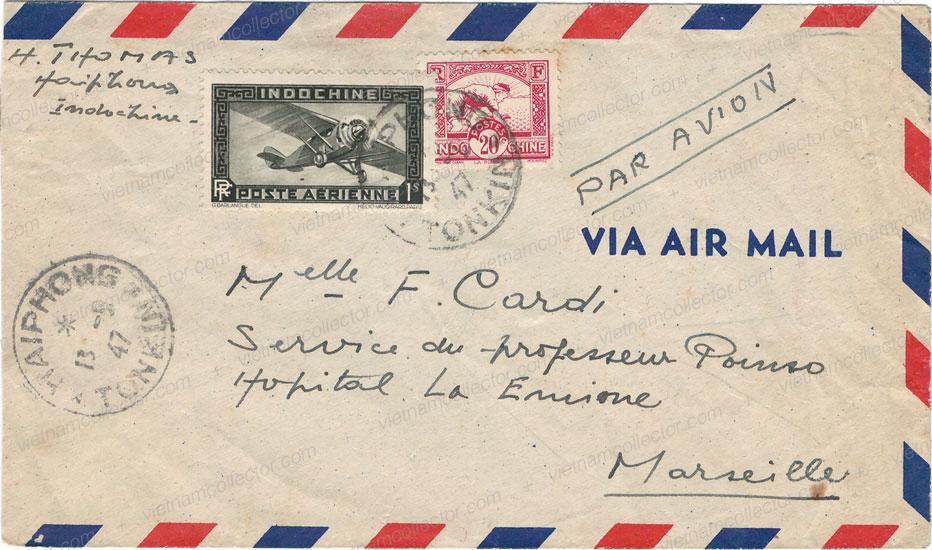 Multiple franking of the 1P value (2) paying an overall postage of 2P on an international air mail letter sent from Saigon to India in November of 1950. The letter was judged to be under-paid and hence a black “T” hand stamp and an oval cachet were applied to indicate that additional postage was due upon arrival. In India another rectangular cachet (Foreign Postage Due – Annas-Pies) was applied to indicate the amount that had to be collected. Various Indian arrival transit on the reverse.
Multiple franking of the 1P value (2) paying an overall postage of 2P on an international air mail letter sent from Saigon to India in November of 1950. The letter was judged to be under-paid and hence a black “T” hand stamp and an oval cachet were applied to indicate that additional postage was due upon arrival. In India another rectangular cachet (Foreign Postage Due – Annas-Pies) was applied to indicate the amount that had to be collected. Various Indian arrival transit on the reverse.
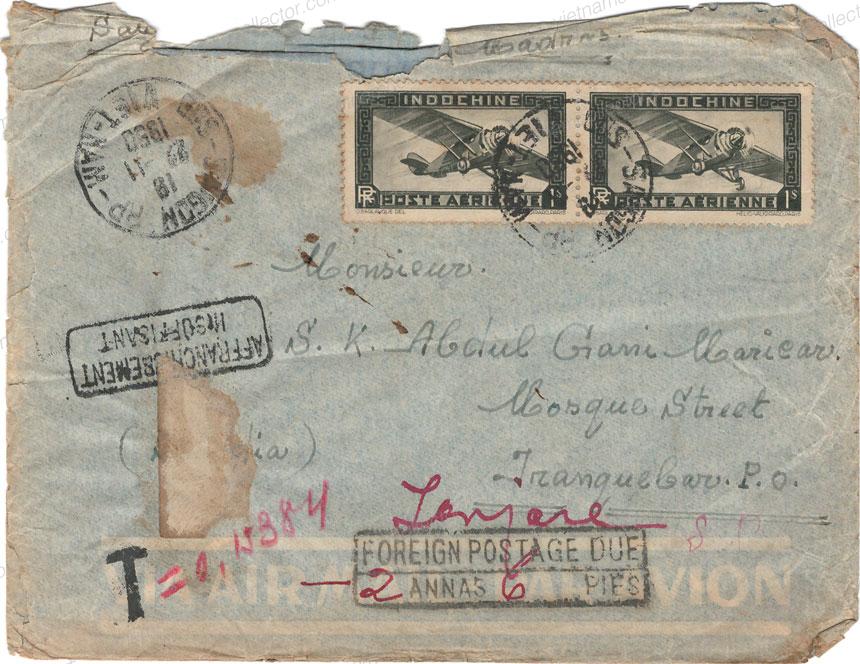 Mixed franking of the 30C Domestic Scenes II stamps together with the 60C and 1P Air Mail stamps paying an overall postage of 1.90P on an international air mail letter sent from Battambang, Cambodia to France in January of 1941. This was during the Japanese Occupation of Cambodia. The letter was addressed to Ardeche which was located in the Vichy territory of the country. The Vichy regime was associated with the German occupiers, so it is not quite clear why the French would have censored this letter upon arrival. It was not censored by the Japanese in Cambodia as this would have resulted in putting a circular “D” hand stamp on the cover that was used in Cambodia. May be the letter was censored upon arrival by mistake?. Pnom Penh and Saigon transit cancels on the reverse.
Mixed franking of the 30C Domestic Scenes II stamps together with the 60C and 1P Air Mail stamps paying an overall postage of 1.90P on an international air mail letter sent from Battambang, Cambodia to France in January of 1941. This was during the Japanese Occupation of Cambodia. The letter was addressed to Ardeche which was located in the Vichy territory of the country. The Vichy regime was associated with the German occupiers, so it is not quite clear why the French would have censored this letter upon arrival. It was not censored by the Japanese in Cambodia as this would have resulted in putting a circular “D” hand stamp on the cover that was used in Cambodia. May be the letter was censored upon arrival by mistake?. Pnom Penh and Saigon transit cancels on the reverse.
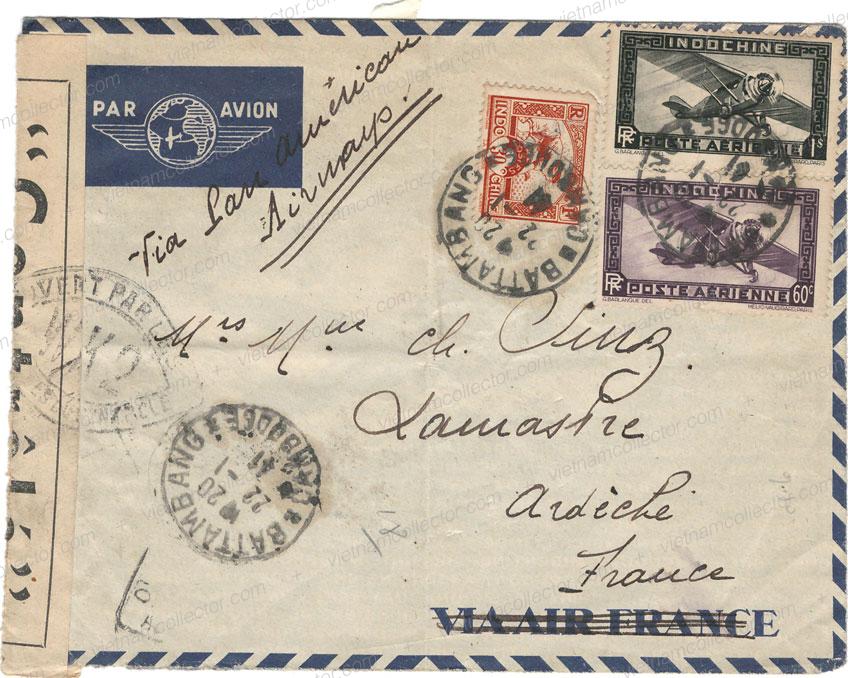 Mixed franking of the 60C and 70C Domestic Scenes II stamps together with the 1P Air Mail stamp paying an overall postage of 3P on a registered international air mail letter sent from Saigon to India in May of 1947. Various Indian arrival cancels on the reverse.
Mixed franking of the 60C and 70C Domestic Scenes II stamps together with the 1P Air Mail stamp paying an overall postage of 3P on a registered international air mail letter sent from Saigon to India in May of 1947. Various Indian arrival cancels on the reverse.
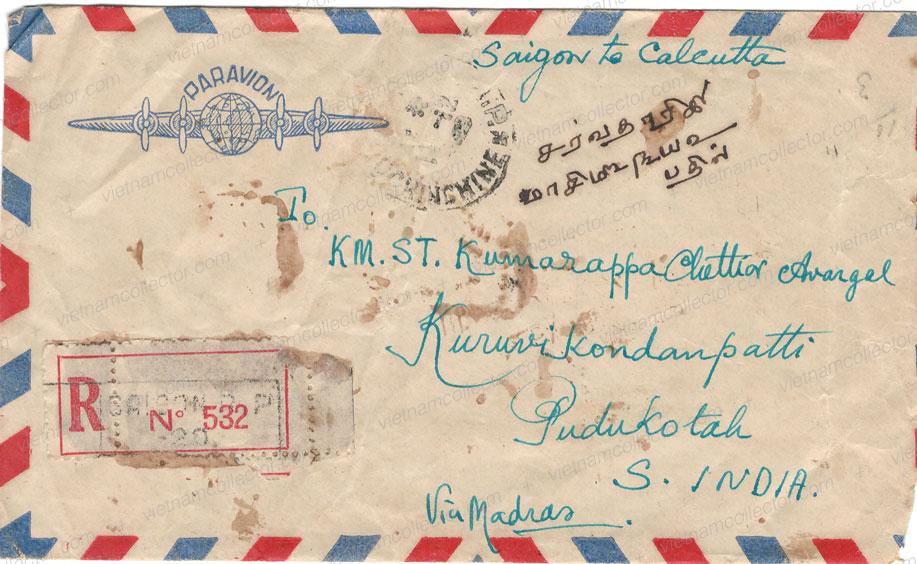
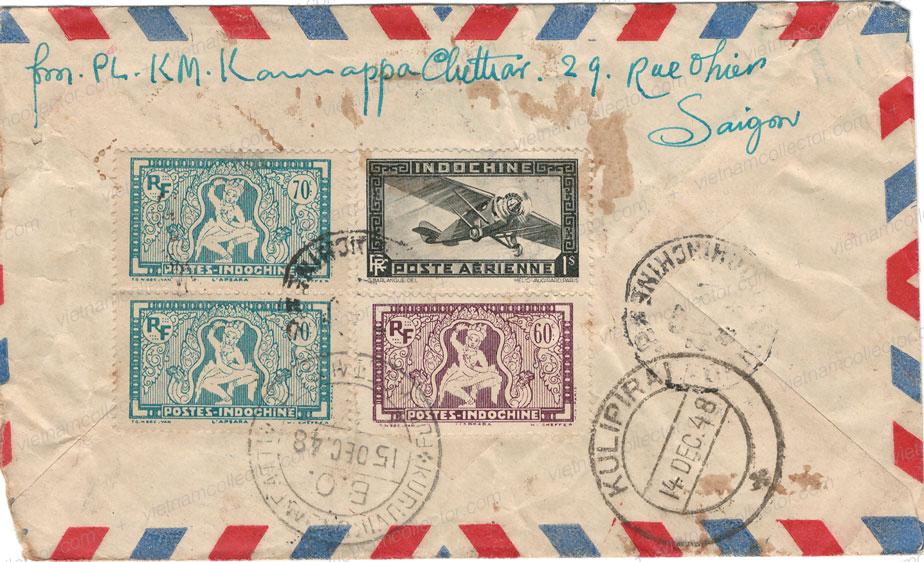 Mixed franking of the 30C and 60C Domestic Scenes II stamps together with the 1P Air Mail stamp paying an overall postage of 1.90P on an international air mail letter (full contents preserved) sent from Saigon to India in November of 1949. Indian arrival cancel on the reverse.
Mixed franking of the 30C and 60C Domestic Scenes II stamps together with the 1P Air Mail stamp paying an overall postage of 1.90P on an international air mail letter (full contents preserved) sent from Saigon to India in November of 1949. Indian arrival cancel on the reverse.
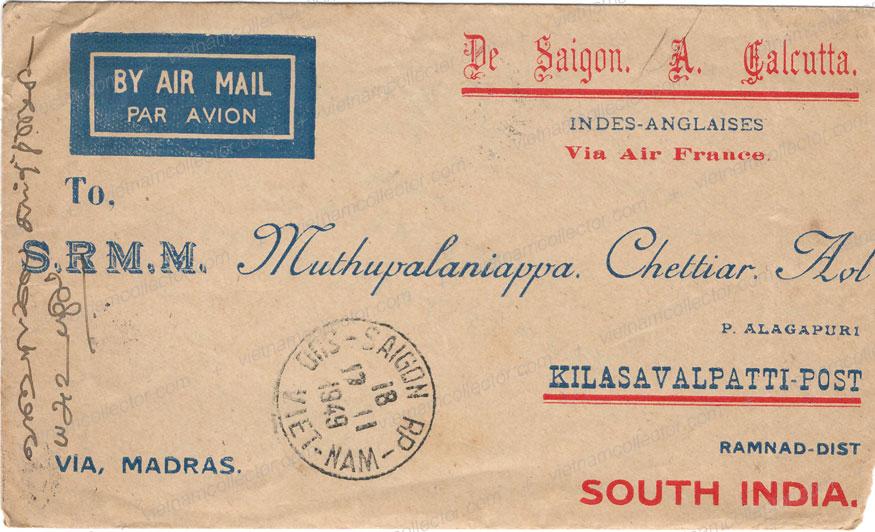
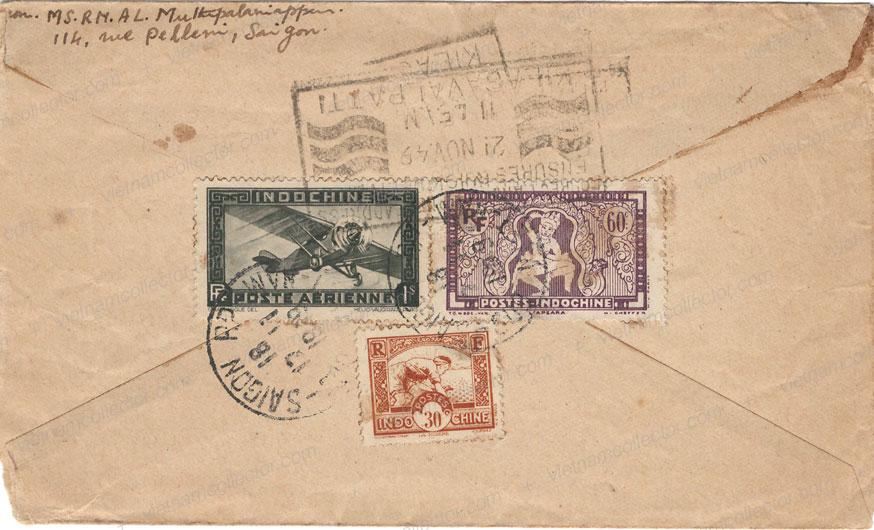
Single franking of the 2P value on a domestic air mail letter sent from Hue to Saigon in December of 1950. Bi-lingual Independence propaganda cachet on front.
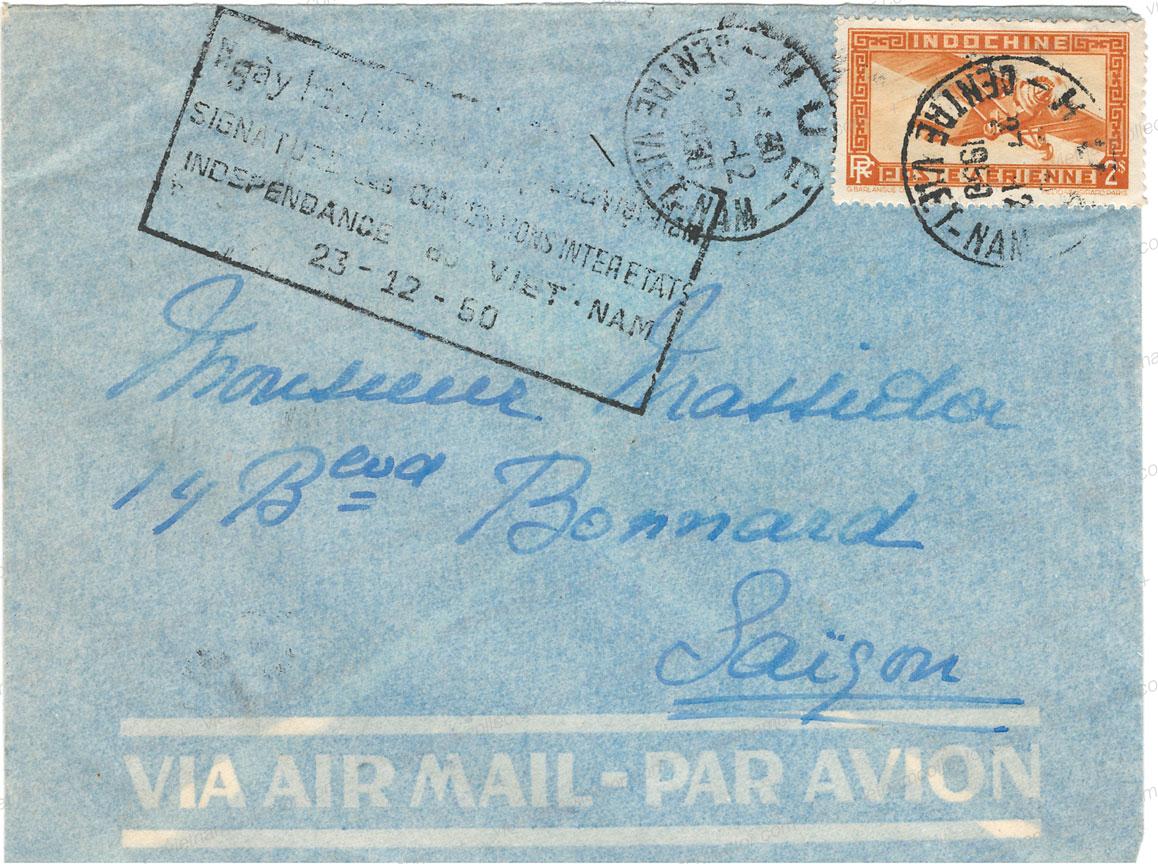
Mixed franking of the 50C Domestic Scenes II stamps together with the 2P Air Mail stamp paying an overall postage of 3P on an international air mail letter sent from Hanoi to Dakar, Senegal in December of 1950. Senegal was a rather rare destination. Black propaganda cachet “Day of complete Independence 23. December, 1950” on front.
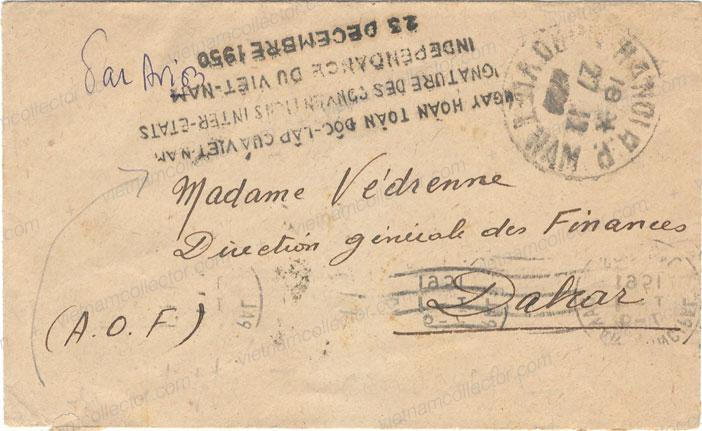
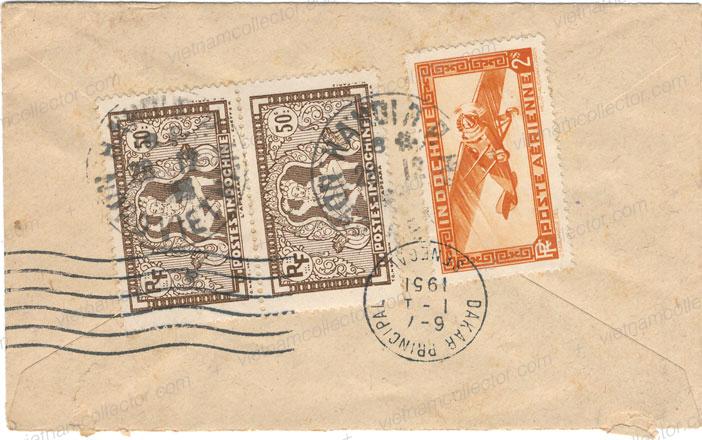 Mixed franking of the 1P and 2P Air Mail stamps on an international letter sent from Tourane (Da Nang) to France in April of 1951.
Mixed franking of the 1P and 2P Air Mail stamps on an international letter sent from Tourane (Da Nang) to France in April of 1951.
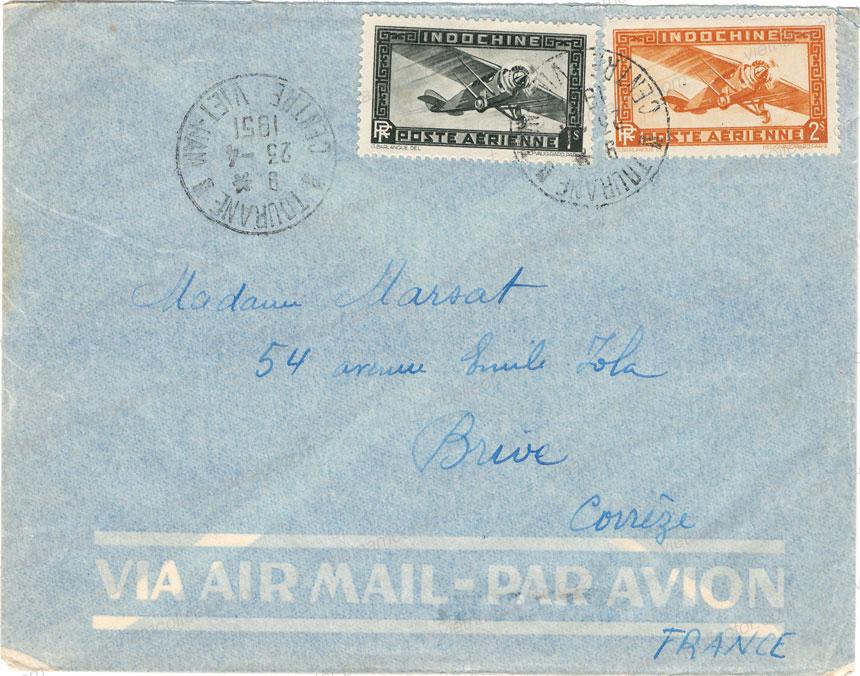 Single franking of the 2P stamp on an international air mail letter sent from Saigon to India in March of 1949. Indian arrival cancels on the reverse.
Single franking of the 2P stamp on an international air mail letter sent from Saigon to India in March of 1949. Indian arrival cancels on the reverse.
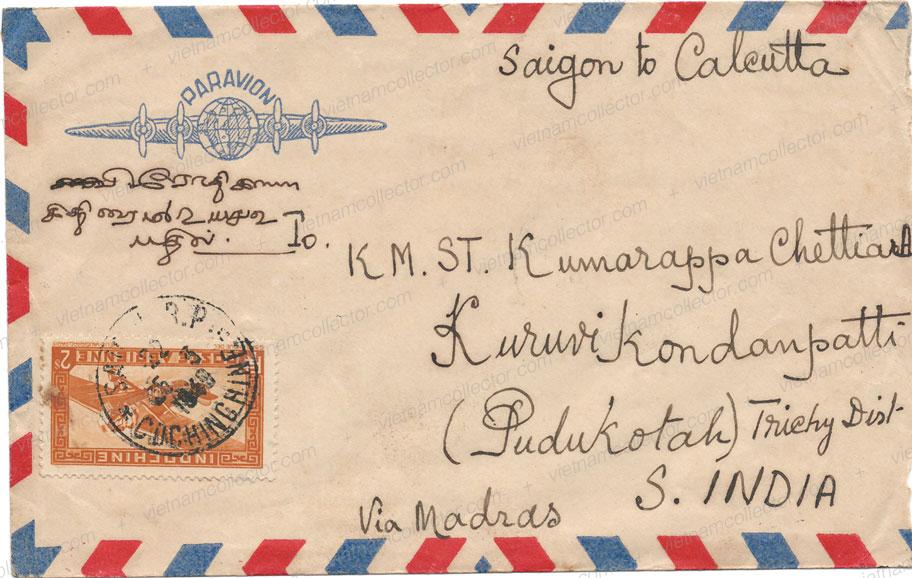 Single franking of the 2P stamp on an international air mail letter (full contents preserved) sent from Phnom Penh, Cambodia to France in August of 1947.
Single franking of the 2P stamp on an international air mail letter (full contents preserved) sent from Phnom Penh, Cambodia to France in August of 1947.
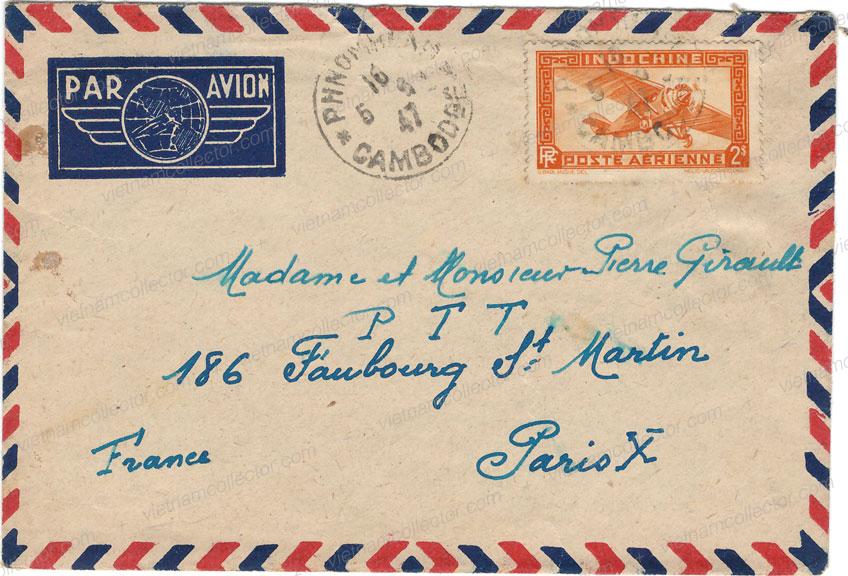
Single franking of the 2P stamp on an international air mail letter sent from Saigon to India in May of 1949. Indian arrival cancels on front.
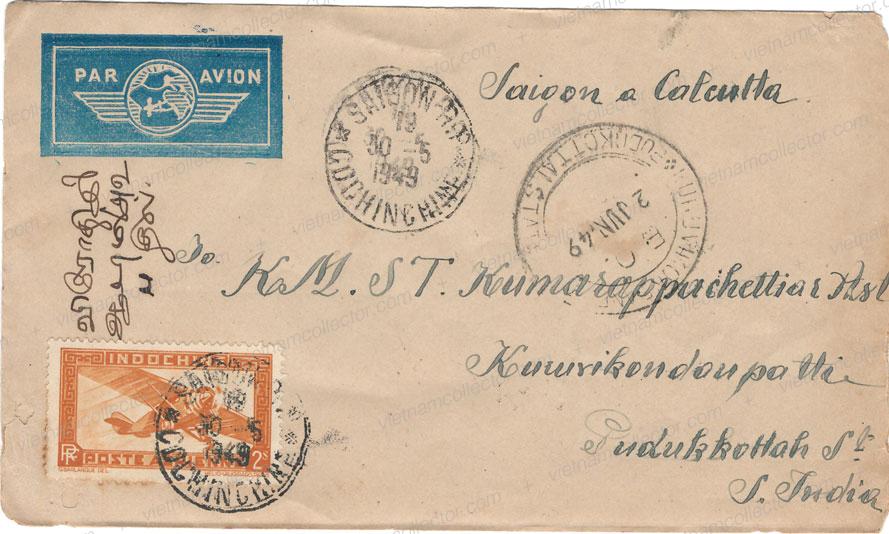
Single franking of the 2P stamp on an international air mail letter sent from Saigon to India in August of 1941. This was during the Japanese Occupation of Indochina. The letter was not censored by the Japanese as it was directed towards Avigon which was located in the territory of Vichy Government that was aligned with the Germany and the Japanese. However it was censored en-route by the Americans as can be seen by the English language banderole that was used to re-seal the letter. Avignon machine arrival cancel on the reverse.
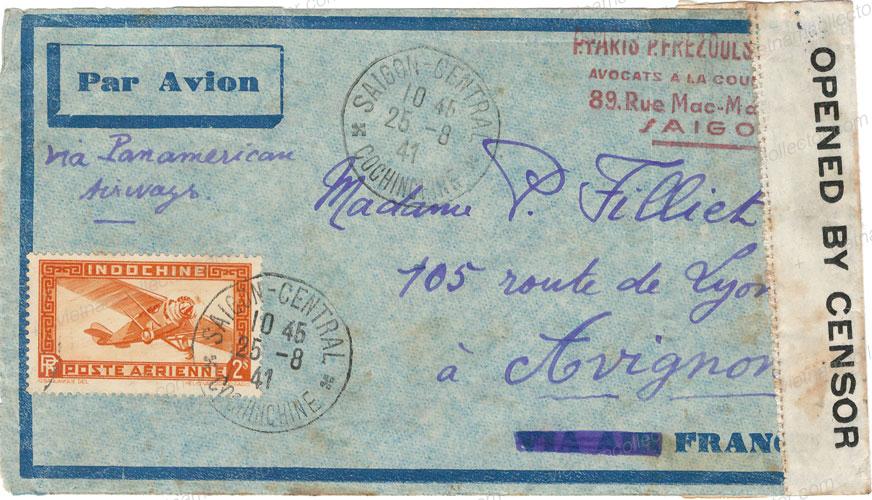
Mixed franking of the 50C Domestic Scenes II stamps together with the 2P Air Mail stamp paying an overall postage of 3P on an international air mail letter sent from Saigon to France in November of 1950. The letter was judged to be under-paid and hence a black “T” hand stamp was applied on front to indicate that additional postage was due upon delivery. A 10F postage due stamp was added in Franc to collect this additional postage.
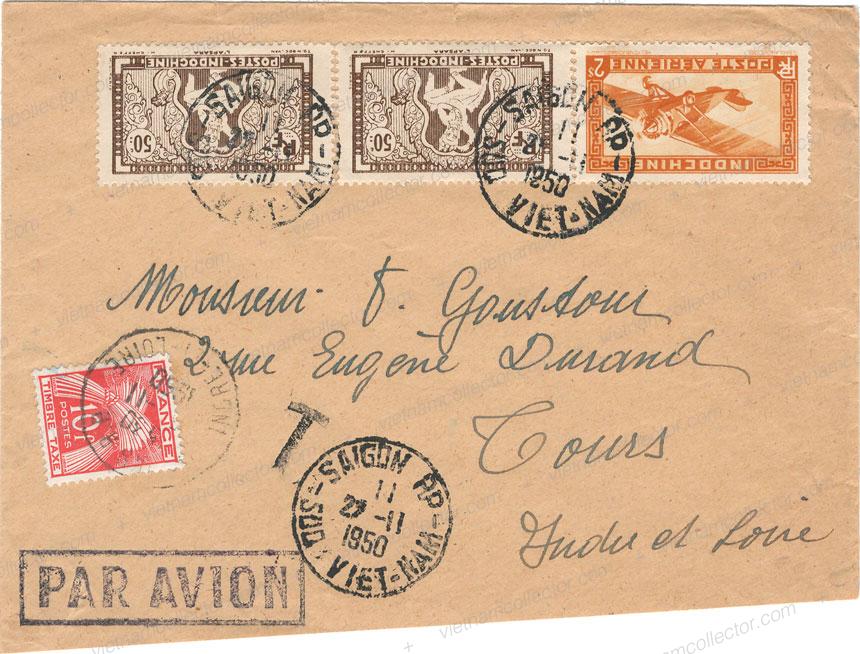 Mixed franking of the 10C Domestic Scenes II stamp together with the 1P, 2P and 10P Air Mail stamps paying an overall postage of 13.10P on an international air mail letter sent from Hanoi to France in December of 1940. The letter was routed via Pan-American Airways through Hong Kong where it was censored by the British as indicated by the black censure cachet and re-sealing banderole.
Mixed franking of the 10C Domestic Scenes II stamp together with the 1P, 2P and 10P Air Mail stamps paying an overall postage of 13.10P on an international air mail letter sent from Hanoi to France in December of 1940. The letter was routed via Pan-American Airways through Hong Kong where it was censored by the British as indicated by the black censure cachet and re-sealing banderole.
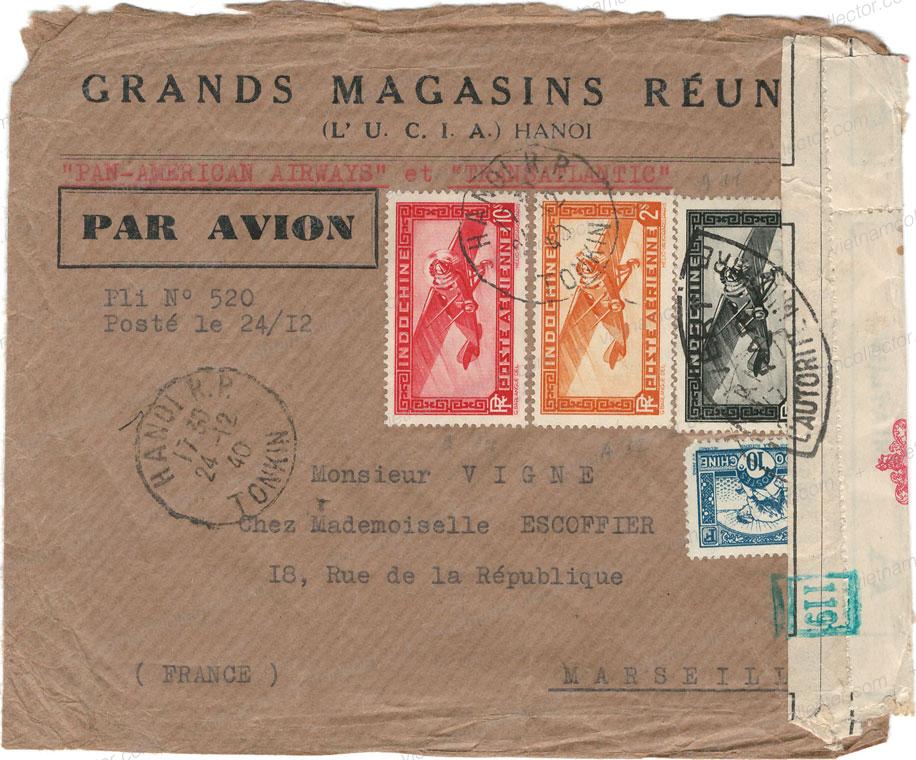 Mixed franking of the 10C Domestic Scenes II stamps together with the 2P Air Mail stamp paying an overall postage of 2.10P on an international air mail letter sent from Hue to France via the Transatlantic route in December of 1940. This was during the Japanese Occupation of Indochina. As a result the letter which was routed through Hong Kong was censured there by the British as indicated by the various censor marks and military re-sealing tape. Son Tay, Hue, Hanoi and Lisbon (Portugal) transit cancels on the reverse.
Mixed franking of the 10C Domestic Scenes II stamps together with the 2P Air Mail stamp paying an overall postage of 2.10P on an international air mail letter sent from Hue to France via the Transatlantic route in December of 1940. This was during the Japanese Occupation of Indochina. As a result the letter which was routed through Hong Kong was censured there by the British as indicated by the various censor marks and military re-sealing tape. Son Tay, Hue, Hanoi and Lisbon (Portugal) transit cancels on the reverse.
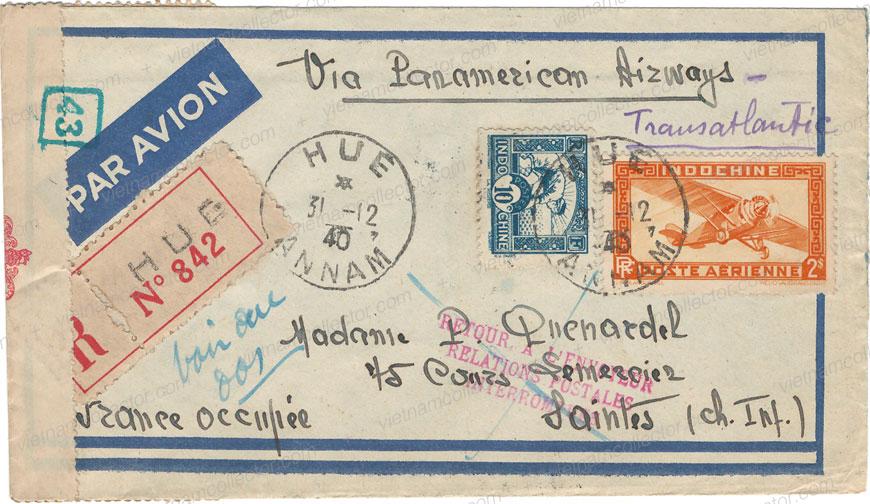 Mixed franking of the 1P Domestic Scenes II stamps together with the 2P Air Mail stamp paying an overall postage of 3P on an international air mail letter sent from Hai Phong to France in April of 1951.
Mixed franking of the 1P Domestic Scenes II stamps together with the 2P Air Mail stamp paying an overall postage of 3P on an international air mail letter sent from Hai Phong to France in April of 1951.
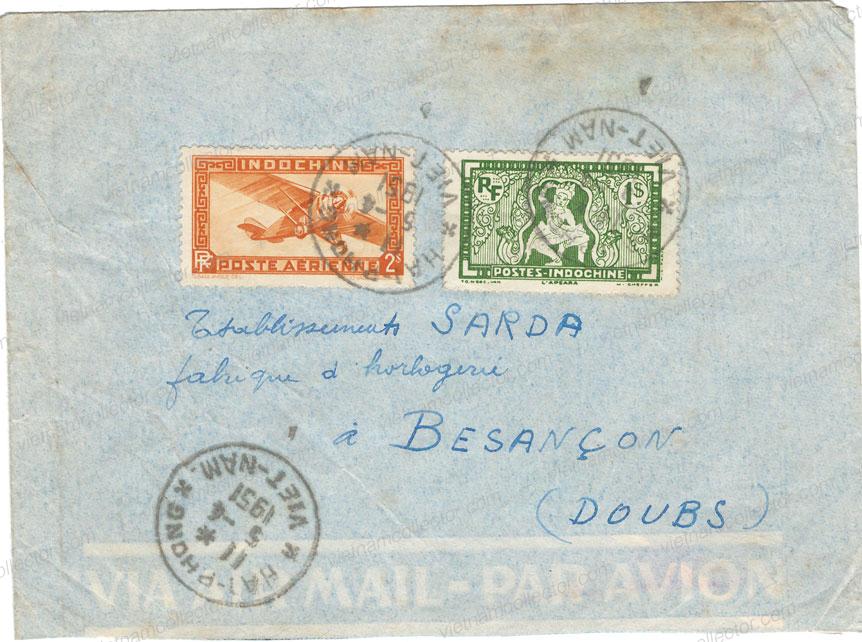 Mixed franking of the 20C Domestic Scenes II stamps together with the 5P Air Mail stamp paying an overall postage of 5.40P on a registered international air mail letter sent from Saigon to India in June of 1951. Indian arrival cancel on the reverse.
Mixed franking of the 20C Domestic Scenes II stamps together with the 5P Air Mail stamp paying an overall postage of 5.40P on a registered international air mail letter sent from Saigon to India in June of 1951. Indian arrival cancel on the reverse.
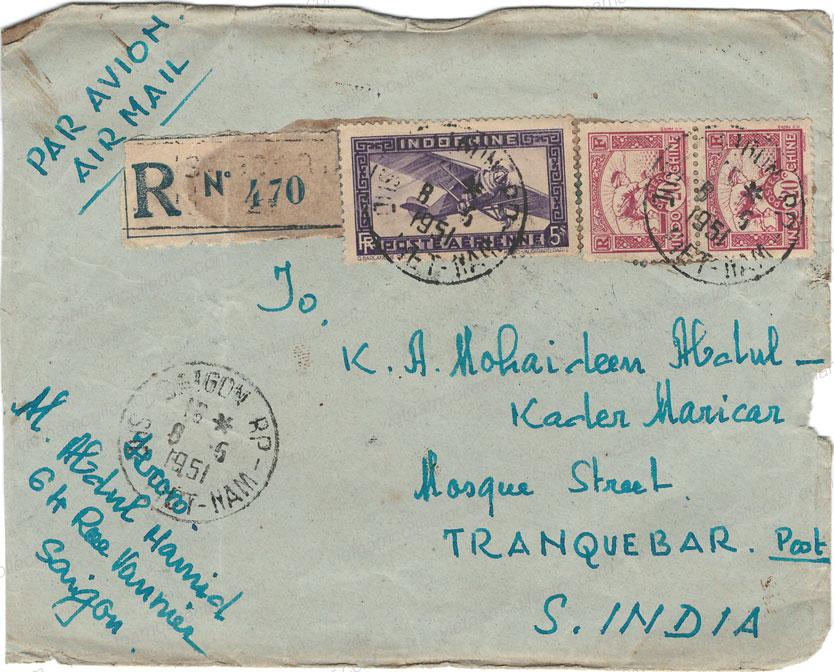 Mixed franking of the 20C Domestic Scenes II stamp together with the 5P Air Mail stamp paying an overall postage of 5.20P on a registered international air mail letter sent from Savannakhet, Laos (rare cancel) to Saigon in August of 1951. Saigon arrival cancel on the reverse.
Mixed franking of the 20C Domestic Scenes II stamp together with the 5P Air Mail stamp paying an overall postage of 5.20P on a registered international air mail letter sent from Savannakhet, Laos (rare cancel) to Saigon in August of 1951. Saigon arrival cancel on the reverse.
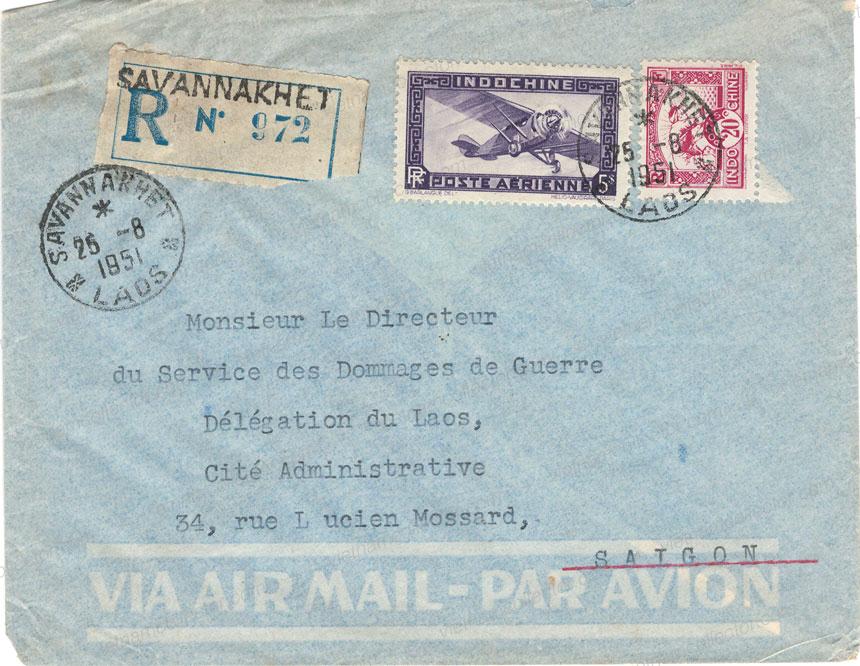 Single franking of the 5P value on a registered international air mail letter sent from Saigon to India in March of 1950. Indian arrival cancels on front and reverse.
Single franking of the 5P value on a registered international air mail letter sent from Saigon to India in March of 1950. Indian arrival cancels on front and reverse.
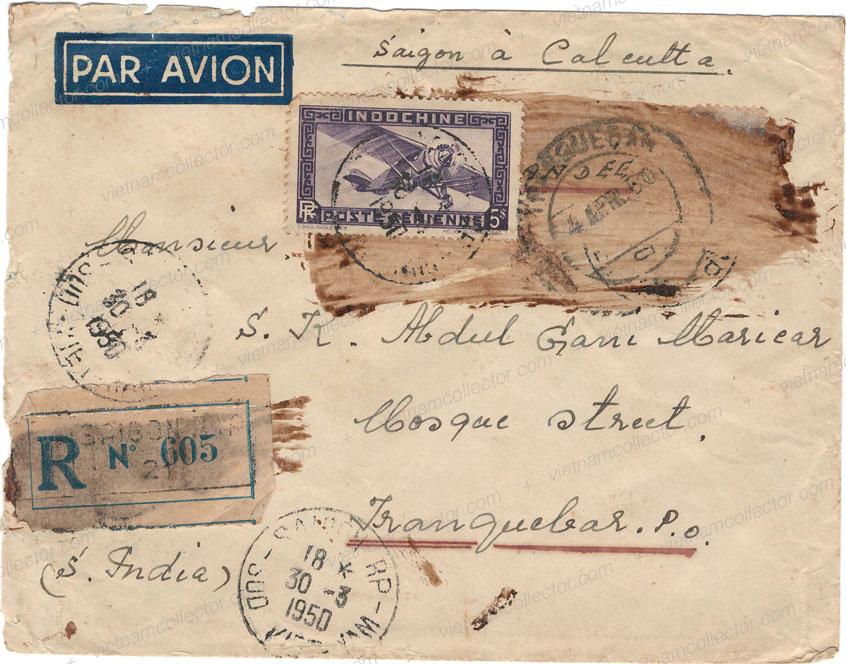 Mixed franking of the 20C Domestic Scenes II stamps together with the 2P and 5P Air Mail stamp paying an overall postage of 9.60P on a registered international air mail letter sent from Hanoi to France inFebruary of 1951.
Mixed franking of the 20C Domestic Scenes II stamps together with the 2P and 5P Air Mail stamp paying an overall postage of 9.60P on a registered international air mail letter sent from Hanoi to France inFebruary of 1951.
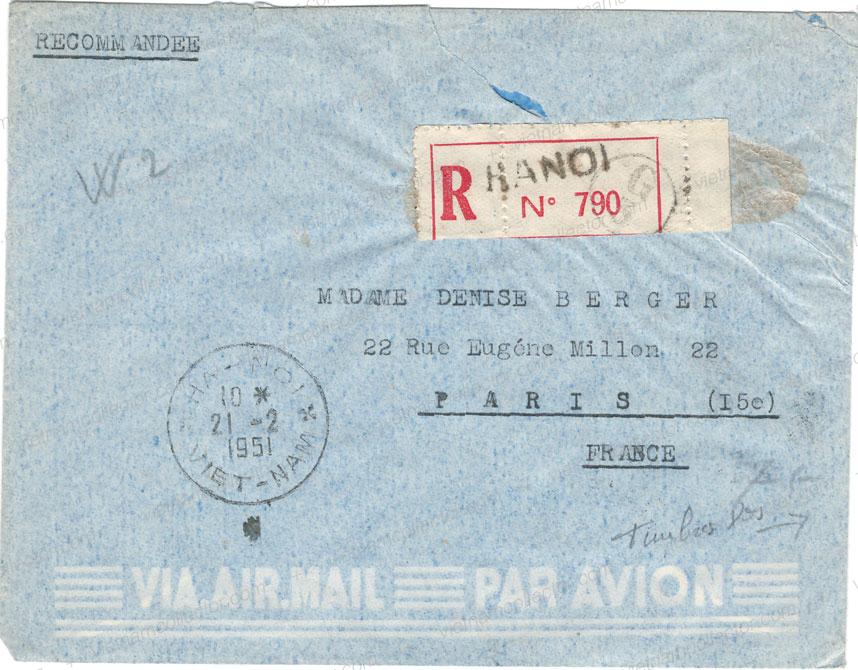
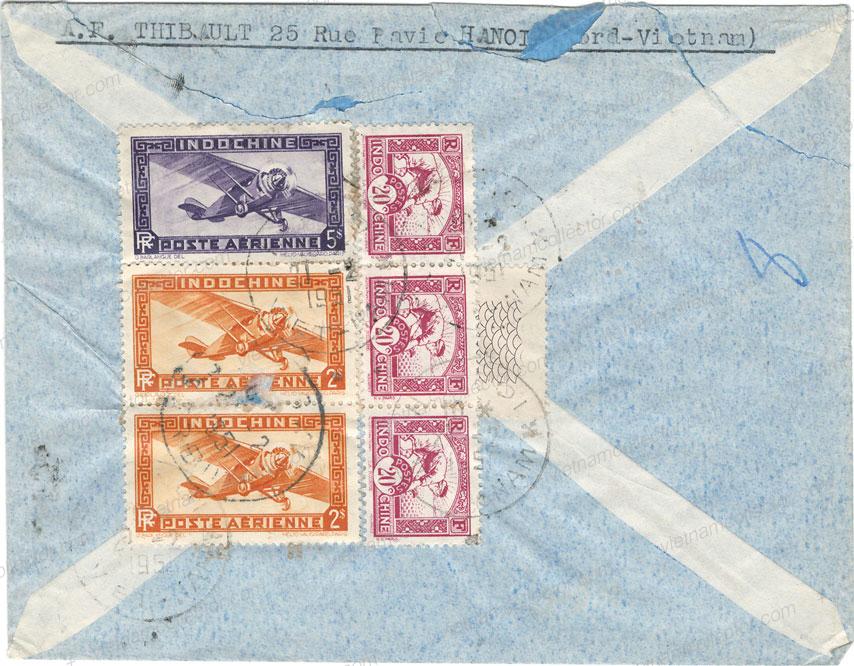 Mixed franking of the 20C Domestic Scenes II stamp together with the 5P Air Mail stamp paying an overall postage of 5.40P on a registered international air mail letter sent from Hai Phong to India in May of 1950. Saigon arrival cancel on the reverse. Saigon transit and Indian arrival cancels on the reverse.
Mixed franking of the 20C Domestic Scenes II stamp together with the 5P Air Mail stamp paying an overall postage of 5.40P on a registered international air mail letter sent from Hai Phong to India in May of 1950. Saigon arrival cancel on the reverse. Saigon transit and Indian arrival cancels on the reverse.
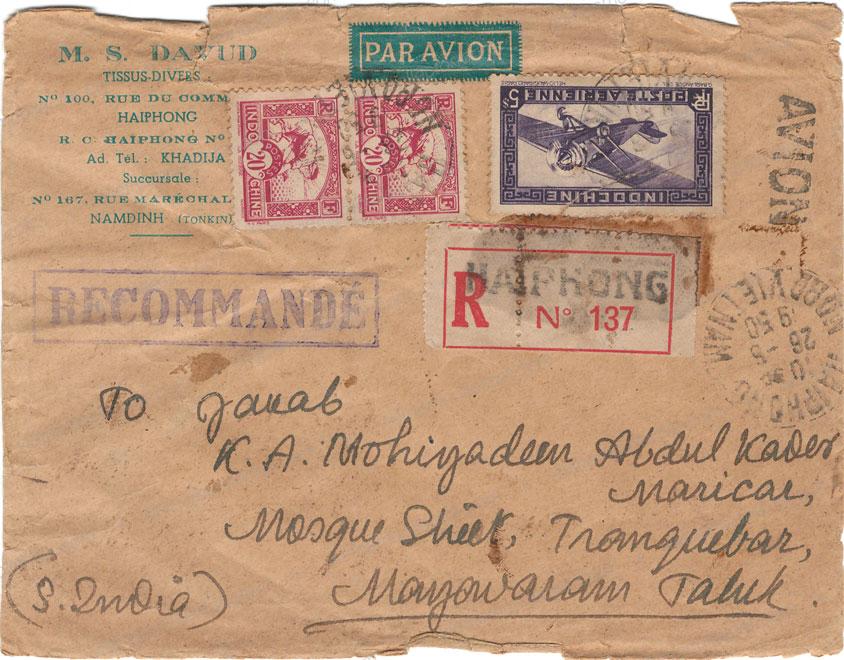 Mixed franking of the 50C Domestic Scenes II stamps together with the 5P Air Mail stamp paying an overall postage of 5.40P on a registered international air mail letter sent from Cholon to India in January of 1951. Saigon transit and Indian arrival cancel on the reverse.
Mixed franking of the 50C Domestic Scenes II stamps together with the 5P Air Mail stamp paying an overall postage of 5.40P on a registered international air mail letter sent from Cholon to India in January of 1951. Saigon transit and Indian arrival cancel on the reverse.
 Mixed franking of the 20C and 1P Domestic Scenes II stamps together with the 5P Air Mail stamp paying an overall postage of 6.40P on a registered international air mail letter sent from Saigon to India in April of 1951. Indian arrival cancel on the reverse.
Mixed franking of the 20C and 1P Domestic Scenes II stamps together with the 5P Air Mail stamp paying an overall postage of 6.40P on a registered international air mail letter sent from Saigon to India in April of 1951. Indian arrival cancel on the reverse.
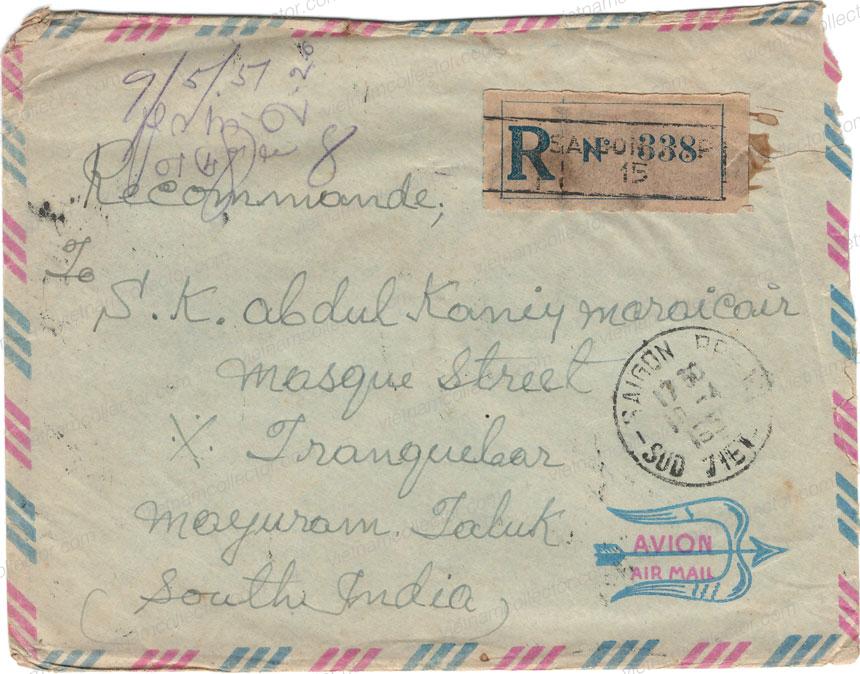
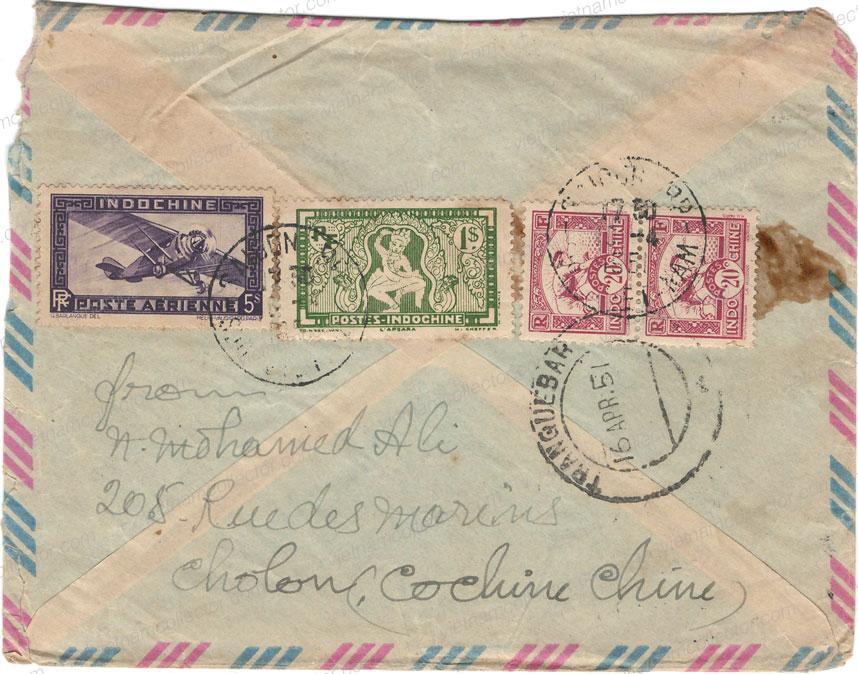 Mixed franking of the 1P Domestic Scenes II stamp together with the 5P Air Mail stamp paying an overall postage of 6P on a registered international air mail letter sent from Saigon to India in October of 1949. Saigon arrival cancel on the reverse. Indian arrival cancels on the reverse.
Mixed franking of the 1P Domestic Scenes II stamp together with the 5P Air Mail stamp paying an overall postage of 6P on a registered international air mail letter sent from Saigon to India in October of 1949. Saigon arrival cancel on the reverse. Indian arrival cancels on the reverse.
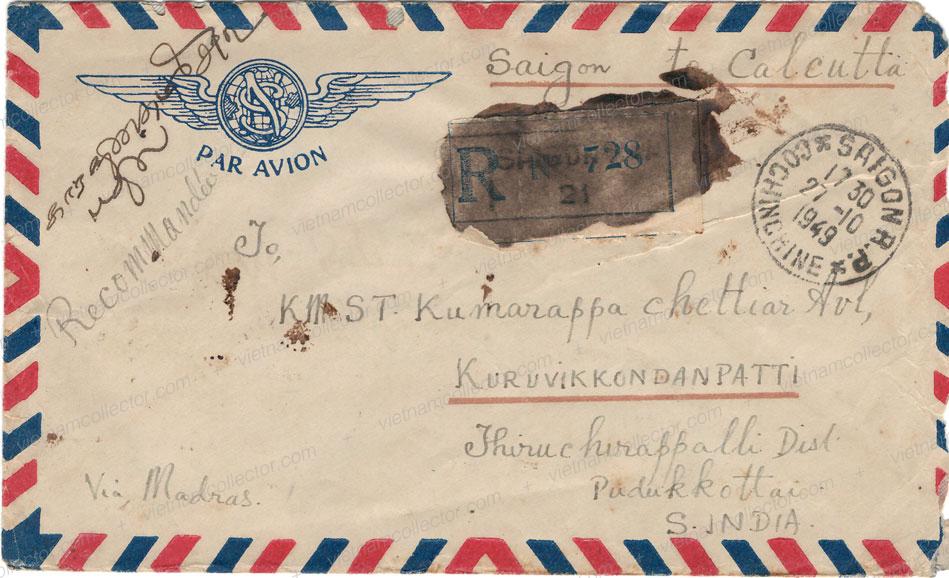
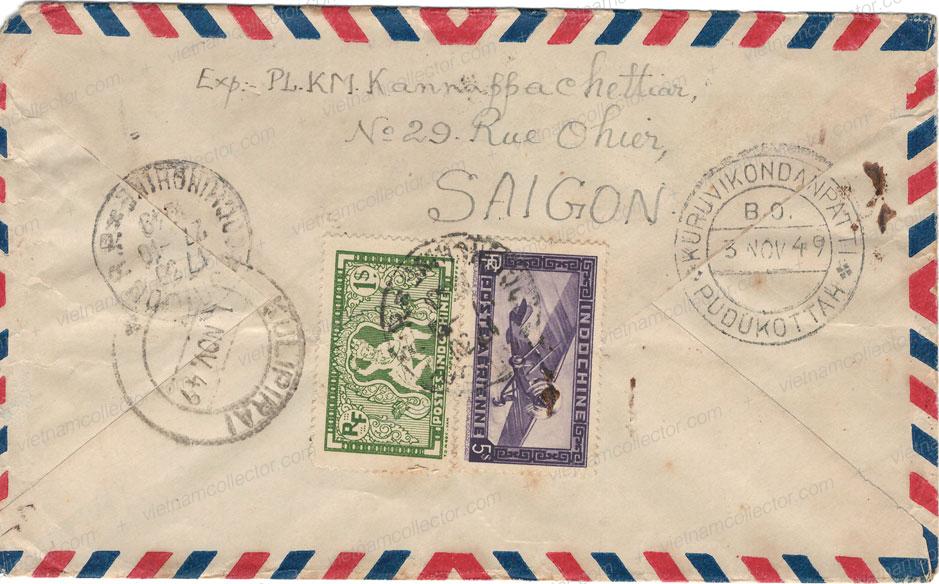 Mixed franking of the 10C, 20C and 60C Domestic Scenes II stamps together with the 5P Air Mail stamp paying an overall postage of 5.90P on a registered international air mail letter sent from Saigon to India in November of 1950. Indian arrival cancel on the reverse.
Mixed franking of the 10C, 20C and 60C Domestic Scenes II stamps together with the 5P Air Mail stamp paying an overall postage of 5.90P on a registered international air mail letter sent from Saigon to India in November of 1950. Indian arrival cancel on the reverse.

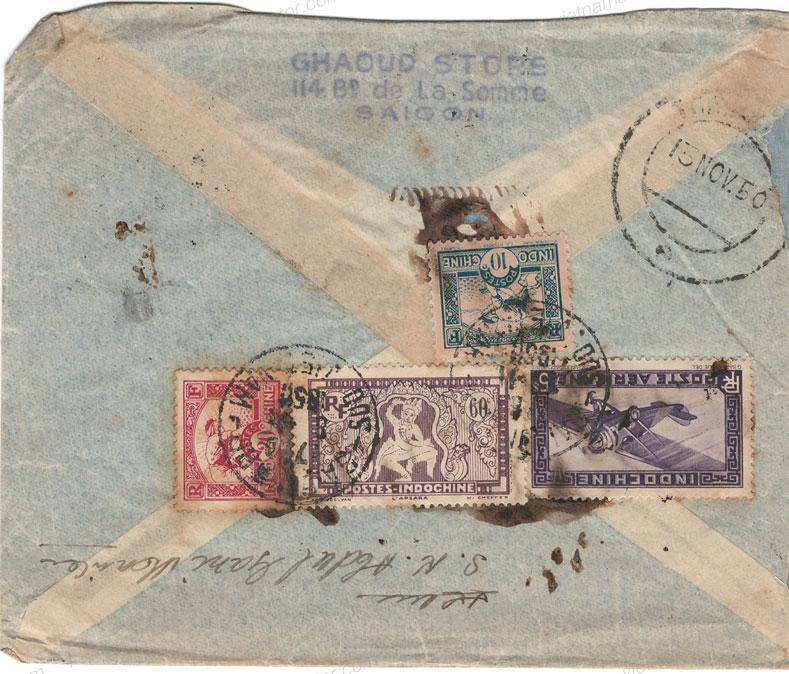
Mixed franking of the 20C Domestic Scenes II stamp together with the 5P Air Mail stamp paying an overall postage of 5.40P on a pouched U.S. Embassy mail sent from Saigon in January of 1951. According to Vietnamese Law all mail had to be franked by Vietnamese postage stamps even if it was transported by private courier or, like here, by a secret embassy pouch. Since it never saw the Vietnamese postal system it was cancelled in Washington D.C. upon arrival. Violet cachet of the embassy on front.
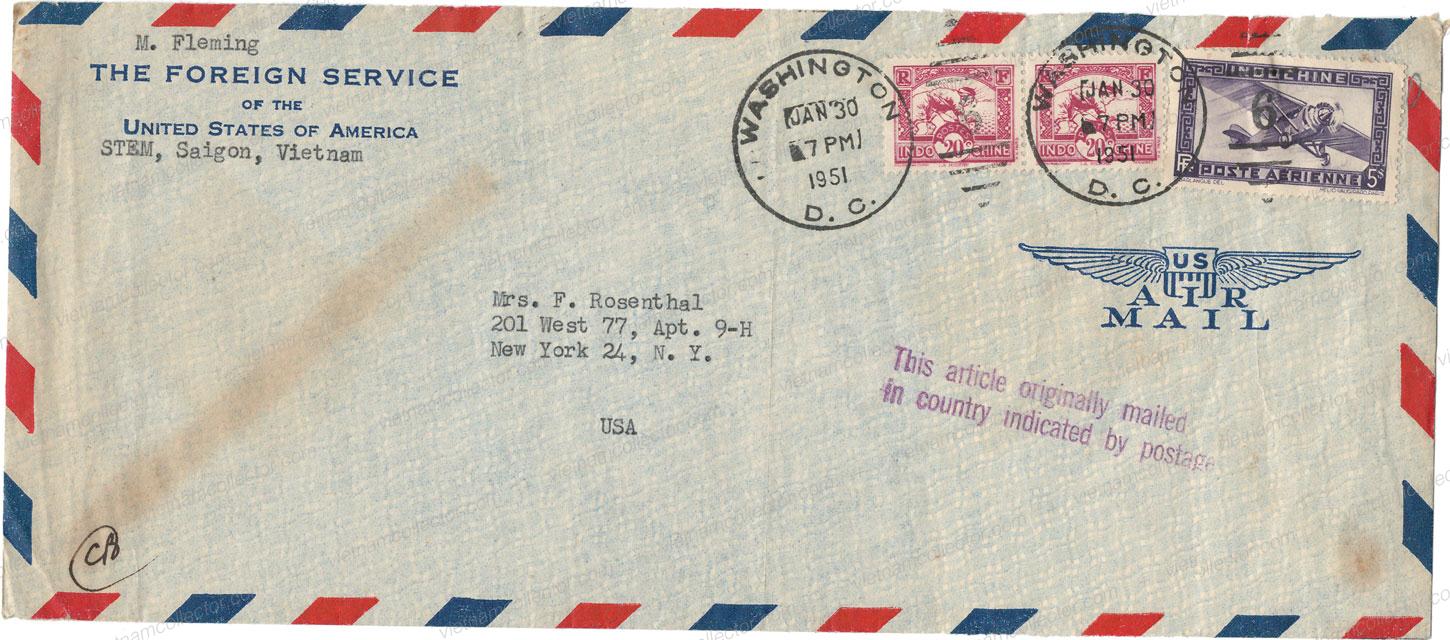
Below are package labels that were attached to 3 kg sacks of rice or rice powder each using thread. They all stem from the same correspondence directed from Saigon to Bordeaux. Apparently it was profitable to send rice by mail from Indochina to France. These labels do not look like much but this is what postal history collecting is all about! The great majority of these items were immediately thrown out and so it is very difficult to find them now. Package labels are the some of the rarest items in postal history. Mixed frankings using the highe values of the Air Mail stamps and some of the high values of the Domestic Scene II stamps paying each 18 Piastre. All were ent by registered mail for additional security. Various custom cachets on front.
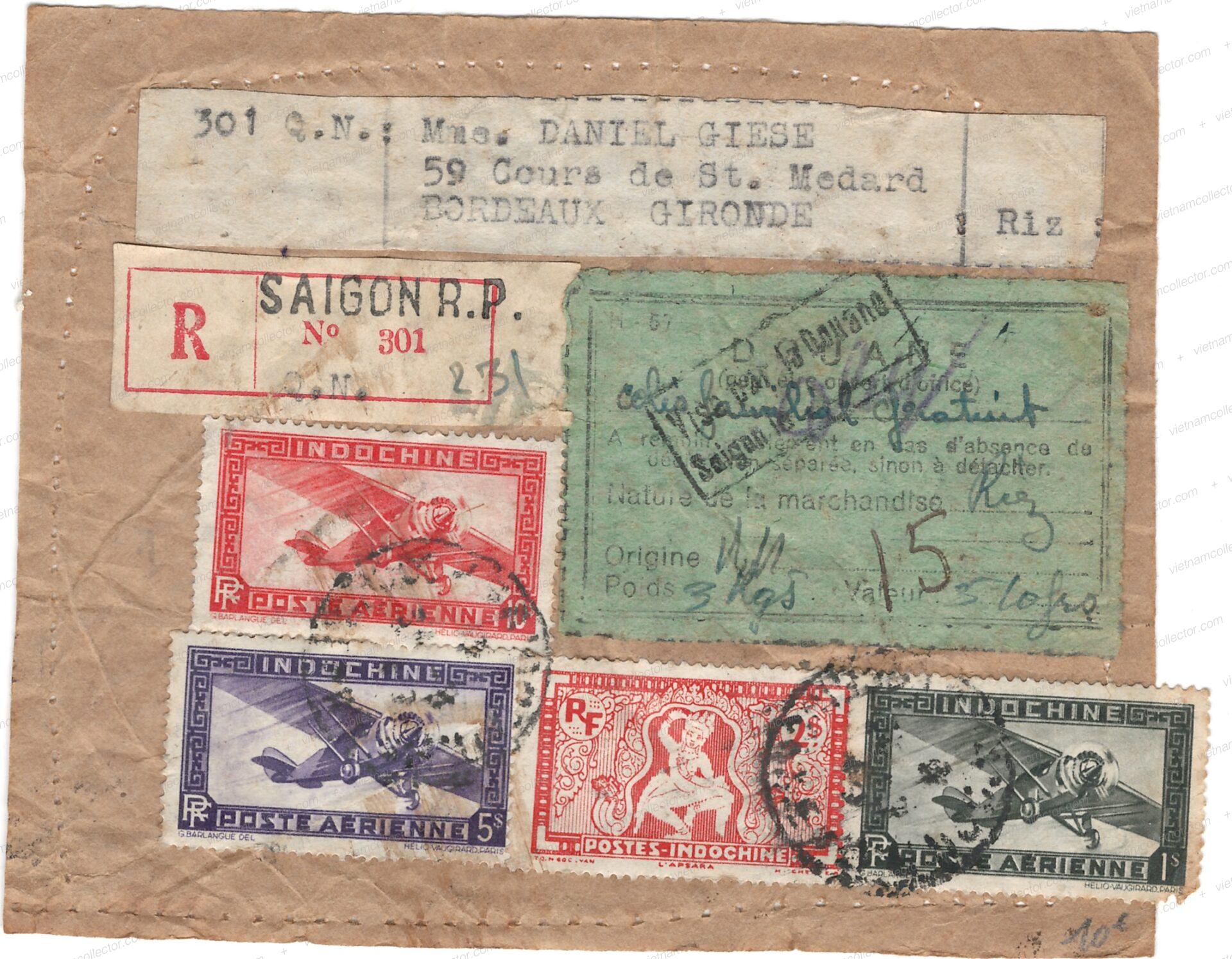
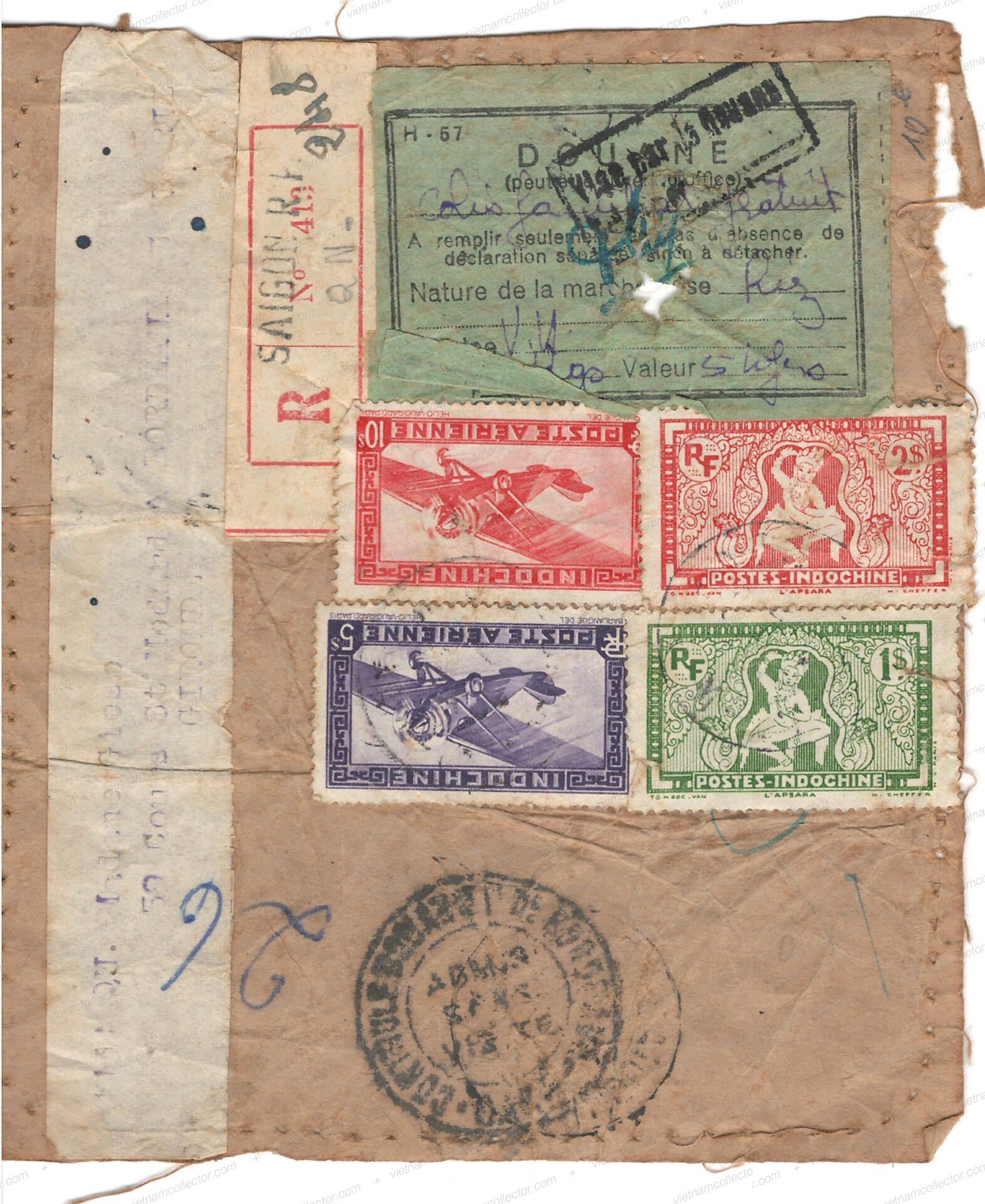
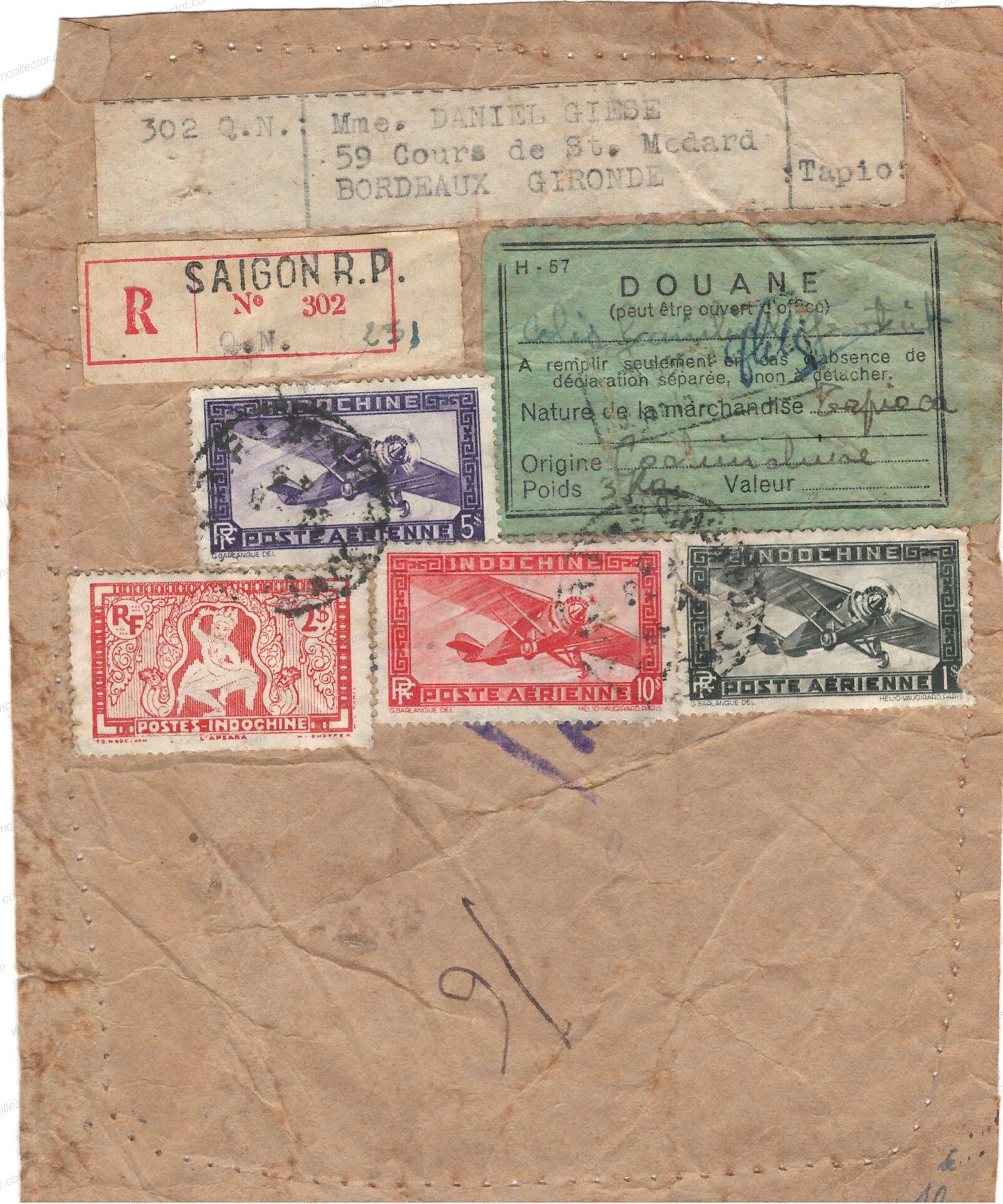
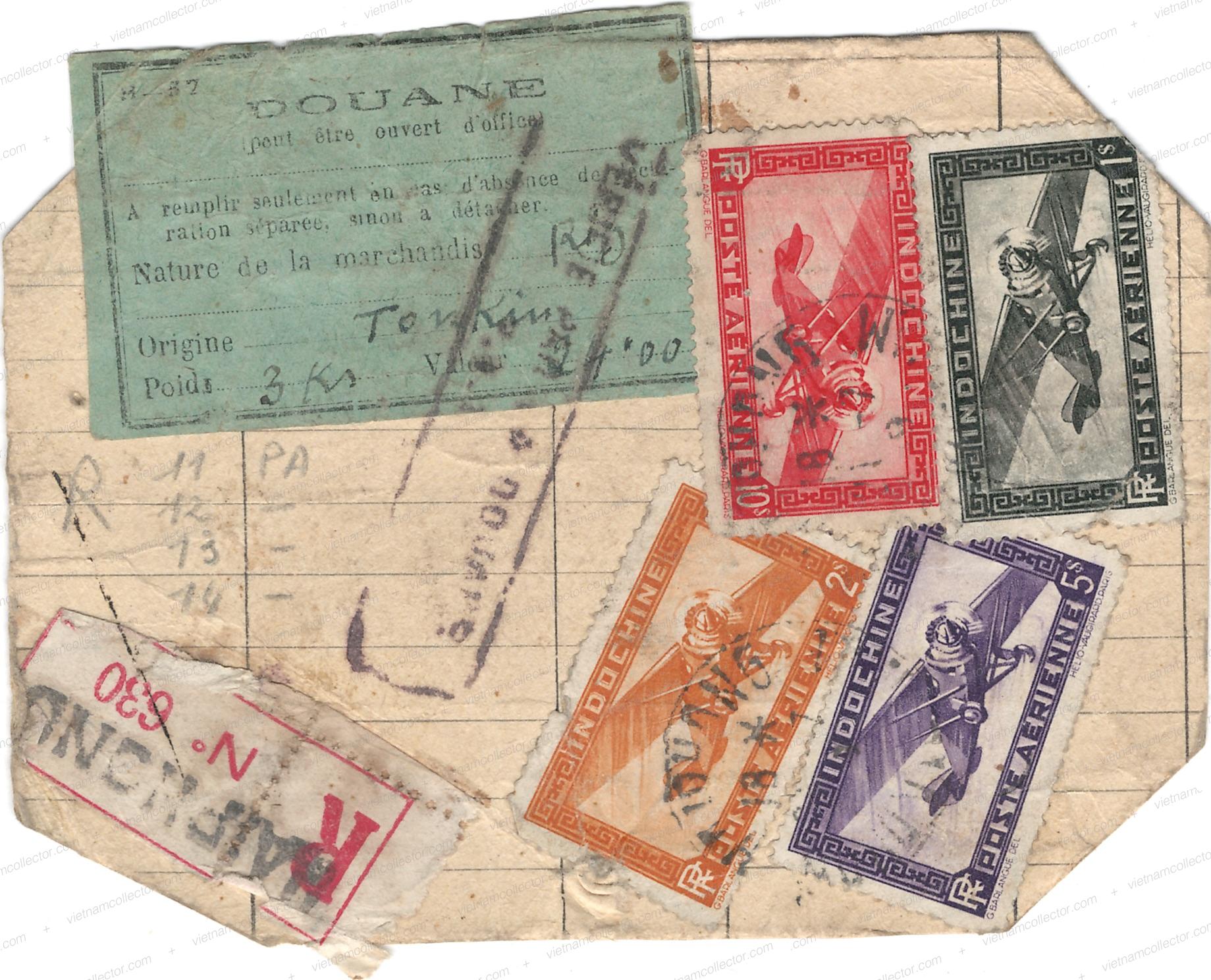
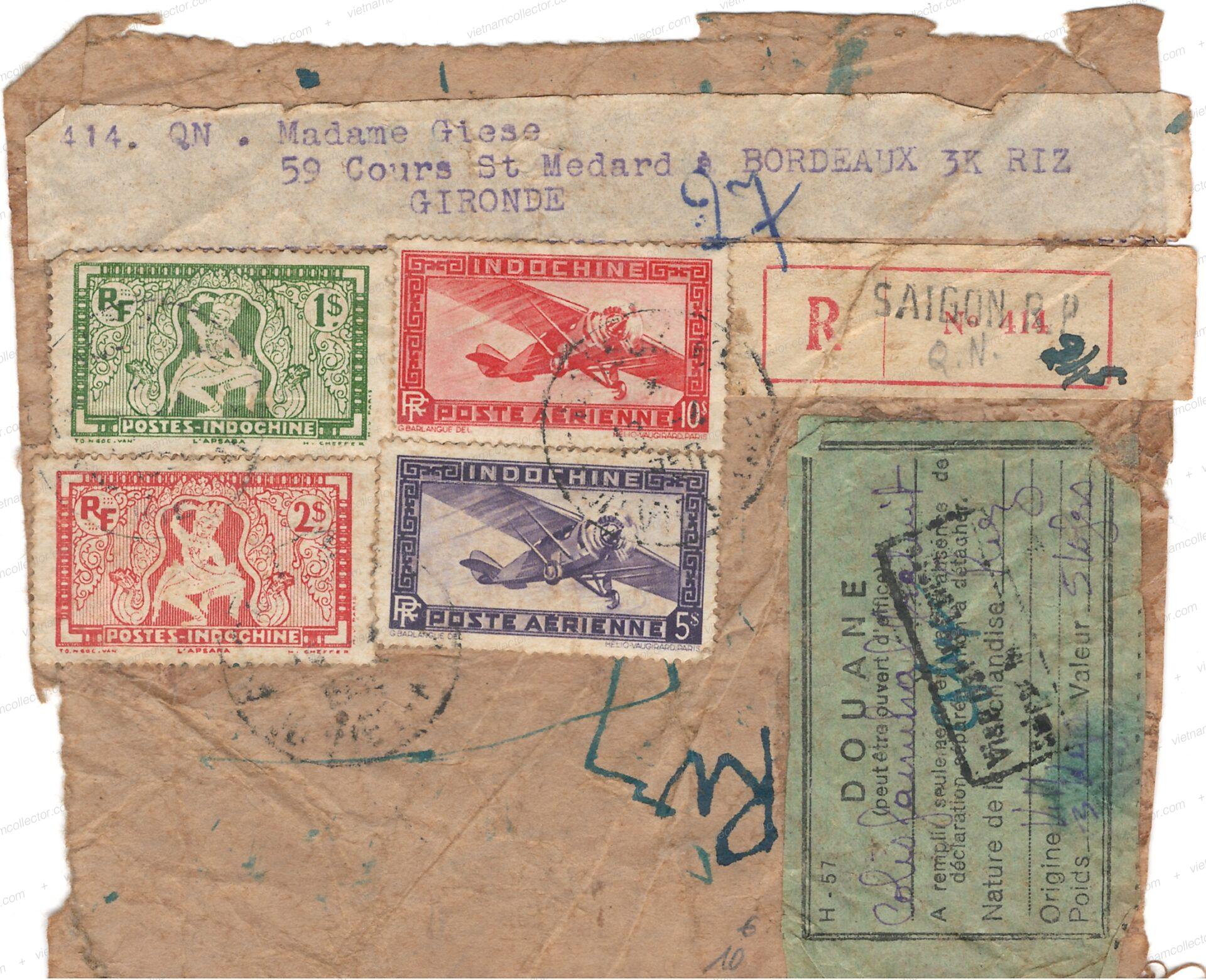
Registration Nr. 090180


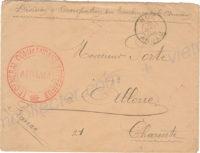
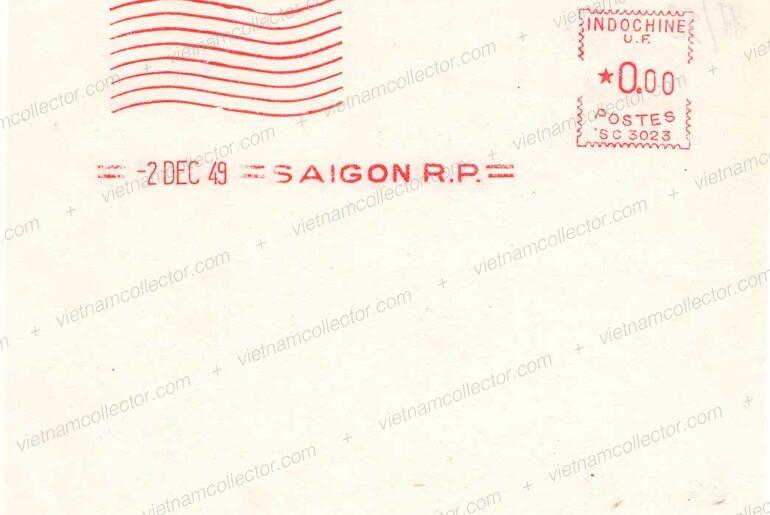
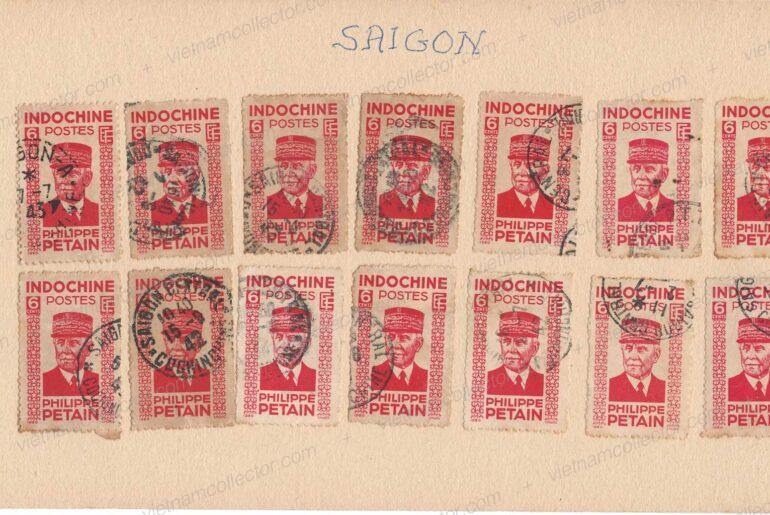
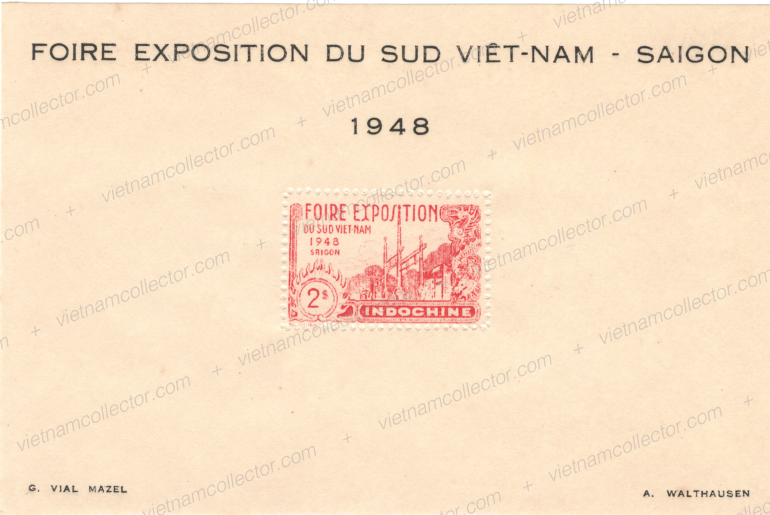
Comments are closed.